-
 LOGISTICS MANAGEMENT FOR SUPPLIER EVALUATION IN AN INDUSTRY USING ARTIFICIAL INTELLIGENCE (FUZZY LOGIC) FOR DECISION MAKING
LOGISTICS MANAGEMENT FOR SUPPLIER EVALUATION IN AN INDUSTRY USING ARTIFICIAL INTELLIGENCE (FUZZY LOGIC) FOR DECISION MAKING Today's quality is an indispensable requirement when it comes to the production of products or services, because with the highly competitive market, a simple factor that does not please the consumer, can be crucial to generate negative points in business operations. With this, the research carried out in a watch factory X, served to analyze the factors that contribute to the performance and analysis of an international supplier in the year 2019 and 2020, and to reach this objective it was necessary to raise the rejected parts indicators in the process of inspection of receiving process and assembly, as well as the rejection replacement service deadline process in order to evaluate the supplier's performance. The need to carry out this analysis, arose through the experience of one of the members of the group, who works at the company, therefore, this article may contribute to maximize the managers' decision making regarding the approval or disqualification of suppliers to produce watches. A quantitative approach, aiming to measure the variables, the procedure for data collection was through excel spreadsheet documents compiled from the SAP program. At the end of this research, improvement actions were suggested for the company according to the application of the supplier evaluation by the fuzzy logic method. The results achieved in this article, aim to work on the evaluation method and thus try to reduce the losses that generate losses with the process of waiting for information to be collected for decision making.
-
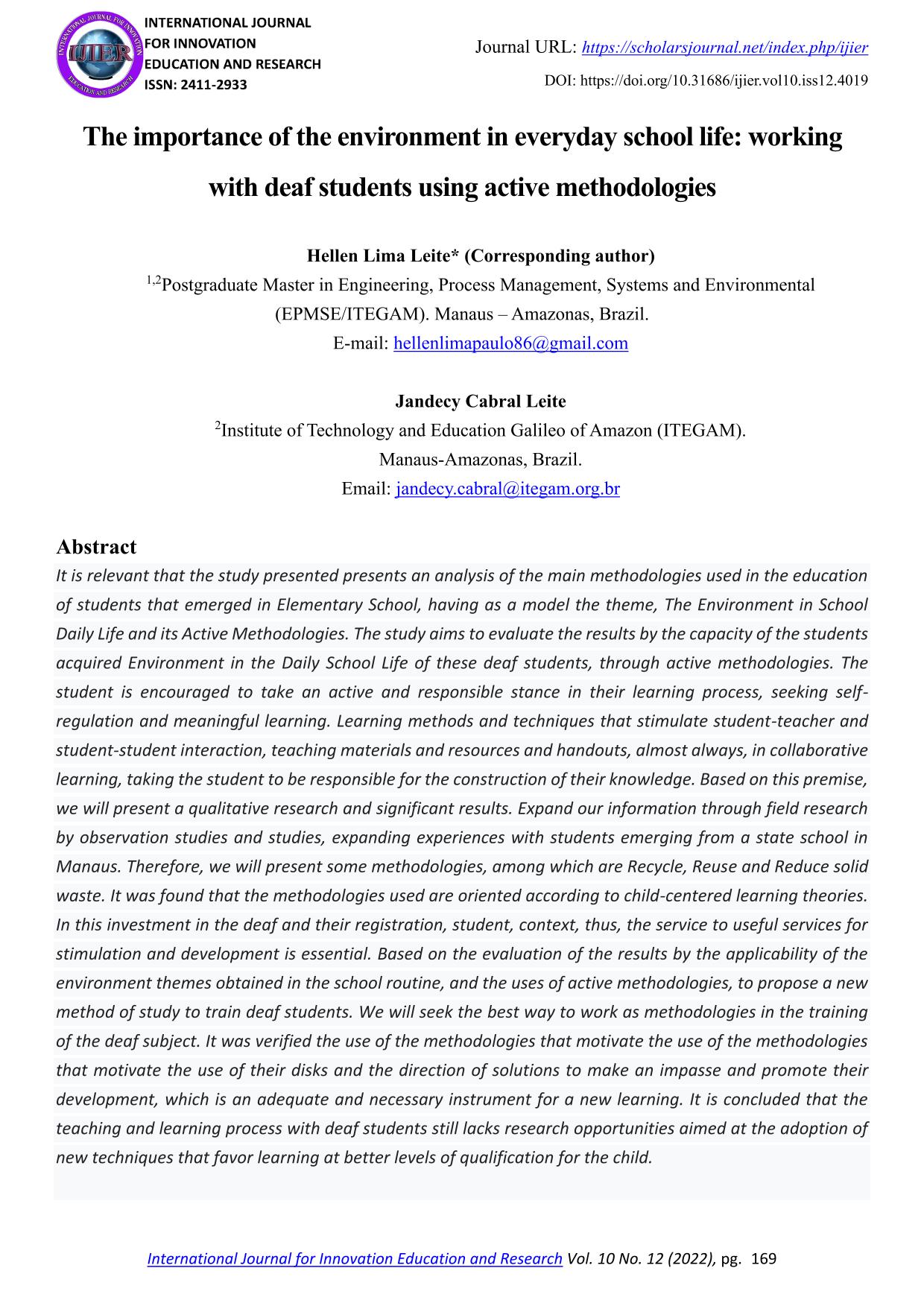 THE IMPORTANCE OF THE ENVIRONMENT IN EVERYDAY SCHOOL LIFE: WORKING WITH DEAF STUDENTS USING ACTIVE METHODOLOGIES
THE IMPORTANCE OF THE ENVIRONMENT IN EVERYDAY SCHOOL LIFE: WORKING WITH DEAF STUDENTS USING ACTIVE METHODOLOGIES It is relevant that the study presented presents an analysis of the main methodologies used in the education of students that emerged in Elementary School, having as a model the theme, The Environment in School Daily Life and its Active Methodologies. The study aims to evaluate the results by the capacity of the students acquired Environment in the Daily School Life of these deaf students, through active methodologies. The student is encouraged to take an active and responsible stance in their learning process, seeking selfregulation and meaningful learning. Learning methods and techniques that stimulate student-teacher and student-student interaction, teaching materials and resources and handouts, almost always, in collaborative learning, taking the student to be responsible for the construction of their knowledge. Based on this premise, we will present a qualitative research and significant results. Expand our information through field research by observation studies and studies, expanding experiences with students emerging from a state school in Manaus. Therefore, we will present some methodologies, among which are Recycle, Reuse and Reduce solid waste. It was found that the methodologies used are oriented according to child-centered learning theories. In this investment in the deaf and their registration, student, context, thus, the service to useful services for stimulation and development is essential. Based on the evaluation of the results by the applicability of the environment themes obtained in the school routine, and the uses of active methodologies, to propose a new method of study to train deaf students. We will seek the best way to work as methodologies in the training of the deaf subject. It was verified the use of the methodologies that motivate the use of the methodologies that motivate the use of their disks and the direction of solutions to make an impasse and promote their development, which is an adequate and necessary instrument for a new learning. It is concluded that the teaching and learning process with deaf students still lacks research opportunities aimed at the adoption of new techniques that favor learning at better levels of qualification for the child.
-
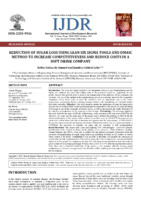 REDUCTION OF SUGAR LOSS USING LEAN SIX SIGMA TOOLS AND DMAIC METHOD TO INCREASE COMPETITIVENESS AND REDUCE COSTS IN A SOFT DRINK COMPANY
REDUCTION OF SUGAR LOSS USING LEAN SIX SIGMA TOOLS AND DMAIC METHOD TO INCREASE COMPETITIVENESS AND REDUCE COSTS IN A SOFT DRINK COMPANY The Lean Six Sigma method is the integration between Lean Manufacturing and Six Sigma, two methods that have been adding value to the productive processes, generating the best results, because they provide tools to assist in the management of the indicators of the companies that use them. The use of this method in the manufacturing process is a strategic factor for the competitive companies, whose focus seeks to meet the customers with an appropriate cost to the market requirements, considering that the existing processes related to the manufacture of a finished product
have their variability. Objective: This study aimed to present the application of Lean Six Sigma tools, describe the use of the DMAIC model and demonstrate its application in the process of syrup and filling of beverage in one of the companies of Simões Group, as well as demonstrate the results obtained with the reduction of production cost by reducing the loss of sugar. Methodology: The technique applied in this study followed the steps of DMAIC methodology, where statistical tools were used to DEFINE the objective, the scope and the main steps of the project and to delimit the problem, to MEASURE the current performance of the process and to reduce the problem area, to ANALYZE the potential root
causes and confirm them with data to determine the opportunities for improvement, to IMPLEMENT the process improvements by developing and testing solutions that address the root causes and finally to CONTROL the processes to maintain the gains and the transition to full implementation. Result/Discussion: This project had a team that applying VOC methodologies - Voice of Customer, identification of the Critical Attributes for the Quality of the customer - CTQs (Critical to Quality), Serpent Diagram and SIPOC, were able to collect with the internal customers information about the
processes of manufacturing of simple syrup, final syrup and filling of drinks in PET bottles, as well as others related to the theme. Conclusion: It was possible to determine and quantify the main process wastes after the total implementation of the actions proposed by the six sigma team, having reached the objective of this project. By comparing the sugar loss with the previous period measured, the analyzed process reduced the average percentage of losses from 2.02% to 0.07% after the implemented actions. Thus, there was a financial contribution of the project to the company with the average annual production cost reduction on sugar waste from $26,056 to $862, resulting in a loss reduction of $25,194
for the company.
-
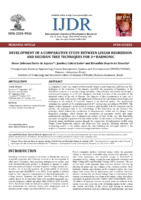 DEVELOPMENT OF A COMPARATIVE STUDY BETWEEN LINEAR REGRESSION AND DECISION TREE TECHNIQUES FOR 3rd HARMONIC
DEVELOPMENT OF A COMPARATIVE STUDY BETWEEN LINEAR REGRESSION AND DECISION TREE TECHNIQUES FOR 3rd HARMONIC A comparative study was carried out between the Simple Linear Regression and Decision Tree techniques in the evaluation of the impacts caused by the generation of harmonics, in the distribution network, in a medium voltage substation. Data collection was carried out through a measurement campaign in a 13.8 kV substation that feeds a portion of the companies in the industrial district of the city of Manaus. The objective of this dissertation is to carry out a
comparative study of the results of the application of Decision Tree and Simple Linear Regression techniques in the analysis of harmonic impacts in an electrical system. The measurement campaign was carried out for a minimum period of 7 calendar days according to PRODIST. The impact of these harmonics on the electrical system is quite harmful, both for consumers and for utilities. The techniques used in the methodology of this dissertation are the Decision Tree
technique, which features the construction of non-parametric models and the Simple Linear Regression technique, which features the construction of parametric models and simple mathematical calculation, easy to interpret and analyze. of data. In this way, this dissertation presented and applied in practice with case studies actions for the analysis of harmonic impacts in electrical energy distribution systems through the construction of mathematical models using Simple Linear Regression analysis and Regression Tree analysis, obtaining important and enlightening results. in the studies carried out, thus validating the techniques applied in the analysis of harmonic impacts in electrical energy distribution systems.
-
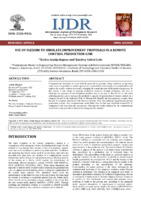 USE OF FLEXSIM TO SIMULATE IMPROVEMENT PROPOSALS IN A REMOTE CONTROL PRODUCTION LINE
USE OF FLEXSIM TO SIMULATE IMPROVEMENT PROPOSALS IN A REMOTE CONTROL PRODUCTION LINE Computational simulation is a tool with the potential to generate a large reduction in operating costs, since it is possible to model a process in a controllable environment, test modifications and analyze the results, without necessarily changing the actual structure of the production process. In this article, it was sought to propose productive scenarios through simulation that aims to eliminate the presence of non-compliant products due to the use of flux NC215 in the wave soldering process and to increase the productive capacity for production of remote controls in a company located in the Industrial Pole of Manaus/AM, identify the best proposed scenario from the use of computer simulation with Flexsim software. Data was collected regarding the current production process. The computational model built, was verified and validated successfully in comparison with data from the real process. Through the results obtained by the computational simulation it was possible to identify the best proposed scenario.
-
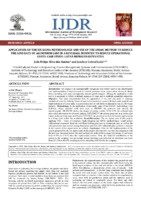 APPLICATION OF THE SIX SIGMA METHODOLOGY AND USE OF THE DMAIC METHOD TO REDUCE THE LOSS RATE OF ALUMINIUM CANS IN A BEVERAGE INDUSTRY TO REDUCE OPERATIONAL COSTS: CASE STUDY: LATAX REFRIGERANTES LTDA
APPLICATION OF THE SIX SIGMA METHODOLOGY AND USE OF THE DMAIC METHOD TO REDUCE THE LOSS RATE OF ALUMINIUM CANS IN A BEVERAGE INDUSTRY TO REDUCE OPERATIONAL COSTS: CASE STUDY: LATAX REFRIGERANTES LTDA Introduction: Six Sigma is an internationally recognized tool widely used in the identification and implementation of improvements in internal processes of an organization, aiming to obtain lower operating costs and, consequently, increase profit margins. During the application of this tool it is necessary to follow a defined sequence of steps and to establish quantified objectives. Objective: This study demonstrates how the application of the tool can assist in reducing operational costs by reducing losses of cans in the production process through cause analysis and implementation of action plans in a production line of soft drinks in aluminum cans in a beverage industry. Methodology: In the application of this study, steps of the DMAIC methodology were followed, where statistics tools were used to DEFINE the problems and identify the improvements, MEASURE during the phases of getting results, ANALYZE the collected data into useful information for decision making, IMPLEMENT the actions proposed in an action plan based on the previous steps and finally CONTROL the processes so that continuous improvement is a living cycle within the institution. Result/Discussion: The six sigma team of this project, applying VOC - Voice of Customer, Snake Diagram and SIPOC methodologies, could interact with internal customers about the soft drink bottling processes in aluminium cans, as well as the other processes that interact among themselves and how this industrialization process is inserted in the context of the organization as a whole. Conclusion: After the full implementation of the actions proposed by the six sigma team of this project, the objective was met. In comparison with the previous measured period, the analyzed process reduced the average percentage of can losses from 0.53% to 0.26% after the implemented actions. Thus, the financial contribution of the project to the company was an average annual operating cost reduction on aluminum can waste from $13,596 to $6,670, resulting in a loss reduction of $6,926 for the company.
-
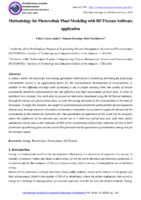 METHODOLOGY FOR PHOTOVOLTAIC PLANT MODELING WITH RETSCREEN SOFTWARE APPLICATION
METHODOLOGY FOR PHOTOVOLTAIC PLANT MODELING WITH RETSCREEN SOFTWARE APPLICATION In today's world, the search for new energy generation alternatives is increasing and being far from large metropolitan centers is an aggravating factor for the socioeconomic development of municipalities. In addition to the difficulty and high costs of keeping a city in proper working order, the quality of service provided by electricity concessionaires has low efficiency and high consumption of fossil fuels. In order to contribute to a solution, this work aims to present an alternative developed using the RETScreen Software, through the design of a photovoltaic plant, to meet the energy demands of the municipalities in the state of Amazonas. Through the research, we sought to understand and present the particularities of each proposed chapter and, through computer simulation, to develop a renewable source plant to supply the demand of the municipality of São Gabriel da Cachoeira-AM. Two possibilities of application of the result can be analyzed, where the fulfillment of the demand was carried out in a total and partial way and, with that, obtain satisfactory results such as the reduction of 50% of the consumption of fossil fuel, reduction of 25% to 50 % of emission of polluting gases and to present the potential that the generation of photovoltaic energy has for the Amazon region
-
 PROFILE OF STATE AND MUNICIPAL SCHOOLS IN THE MUNICIPALITY OF ITACOATIARA: ENVIRONMENTAL EDUCATION CONTEXT
PROFILE OF STATE AND MUNICIPAL SCHOOLS IN THE MUNICIPALITY OF ITACOATIARA: ENVIRONMENTAL EDUCATION CONTEXT The natural environment is essential to life because it is through it that it is possible to extract resources for living beings that are inserted in it. For this, a balance of living beings and the environment is necessary through environmental awareness. The research objectives are to obtain the profile of the analyzed schools, observing how EE is applied in the public network of the municipality, in order to create a manual of practices of applicability of Environmental Education in schools. The research was carried out in thirteen public schools in the city of Itacoatiara/Am. Authorizations were obtained for the visits, observing how the theme is applied in schools and whether they have environmental projects. After the visits, an online questionnaire was applied to teachers and students to detect the qualities and deficiencies of the schools. Finally, the profile of the schools was obtained in order to develop an interdisciplinary application manual in schools in the Amazon. As a result, it was found that public schools are more prepared to work on these themes, and in support of pedagogical resources, given the lack of municipal schools, which, in addition to the lack of material, do not have the application of environmental projects as in state schools in that all apply at least one. All teachers are interested in working in an interdisciplinary way, as the topics are only worked in the classroom and according to the students' results, they are not attractive. It is concluded that there are many deficiencies that need to be corrected, be they structural, pedagogical and material that could benefit the teaching of EE, and thus, make the practices more attractive to the students.
-
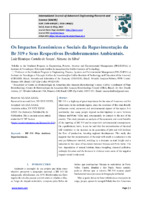 OS IMPACTOS ECONÔMICOS E SOCIAIS DA REPAVIMENTAÇÃO DA BR 319 E SEUS RESPECTIVOS DESDOBRAMENTOS AMBIENTAIS.
OS IMPACTOS ECONÔMICOS E SOCIAIS DA REPAVIMENTAÇÃO DA BR 319 E SEUS RESPECTIVOS DESDOBRAMENTOS AMBIENTAIS. BR 319 is a highway of great importance for the state of Amazonas and for other states in the northern region, since the existence of this road directly influences social, economic and environmental aspects of the region. It is noteworthy that many people depend on this highway to move between Manaus and Porto Velho and, consequently, to connect to the rest of the country. This study presents an analysis of the economic and social benefits of the repaving of BR 319 and its respective environmental consequences. On a preliminary basis, it can be said that the reconstruction of the road will contribute to the increase in the generation of jobs and will facilitate the flow of production, favoring regional development. This study also suggests that the reconstruction of the road will result in a reduction in the cost per kilometer traveled, resulting in a decrease in road freight and a reduction in the value of bus tickets between Manaus and Porto Velho. The loss, degradation of natural habitats, fauna trampling, chemical pollution, anthropic invasion and the increase in violence were some of the negative impacts raised in this work.
-
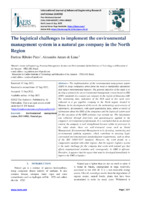 THE LOGISTICAL CHALLENGES TO IMPLEMENT THE ENVIRONMENTAL MANAGEMENT SYSTEM IN A NATURAL GAS COMPANY IN THE NORTH REGION
THE LOGISTICAL CHALLENGES TO IMPLEMENT THE ENVIRONMENTAL MANAGEMENT SYSTEM IN A NATURAL GAS COMPANY IN THE NORTH REGION The implementation of the environmental management system (EMS) in large companies arises from the need to standardize operations and reduce environmental impacts. The general objective of the study is to develop a protocol for an environmental management system based on ISO 14001 standards in a natural gas company in the region of Amazonas-AM. The monitoring data, indicators of the SGA used in this work were collected in a gas pipeline company in the North region, located in Manaus. In the development of this work, the methodology used consists of exploratory, documentary, with quali-quantitative data, where a survey of information about the EMS of the companies and the logistical system used for the execution of the EMS activities was carried out. The information was collected through interviews and questionnaires applied to the company's environmental professionals. It is concluded that in an internal context, the company is well strengthened because within its processes in the value chain, there are well-structured areas such as Social Management, Environmental Management in its licensing, monitoring and environmental auditing segments, which contribute to ensuring legal, contractual and international standardization requirements, such as those of the ISO 14001:2015 standard. However, the work found, in a comparative analysis with other regions, that the region's logistics system is the main challenge for the company that works with natural gas that affects organizational activities and, consequently, its EMS is affected. Therefore, it appears that the aspect that must be developed immediately to improve the EMS is logistics.
-
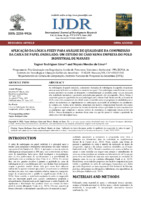 APLICAÇÃO DA LÓGICA FUZZY PARA ANÁLISE DE QUALIDADE DA COMPRESSÃO DA CAIXA DE PAPEL ONDULADO: UM ESTUDO DE CASO NUMA EMPRESA DO POLO INDUSTRIAL DE MANAUS
APLICAÇÃO DA LÓGICA FUZZY PARA ANÁLISE DE QUALIDADE DA COMPRESSÃO DA CAIXA DE PAPEL ONDULADO: UM ESTUDO DE CASO NUMA EMPRESA DO POLO INDUSTRIAL DE MANAUS As embalagens de papel ondulado, comumente chamadas de embalagens de papelão, despontam entre as mais utilizadas na indústria e comércio em geral. Tais embalagens consolidaram-se como recurso preferido no tocante ao transporte e comercialização de produtos uma vez que possuem alta resistência mecânica e geometria projetada para garantir alto desempenho. Desta forma, é necessário garantir a qualidade de uma embalagem até o cliente final. Neste sentido, a fórmula de McKee é um dos mecanismos de cálculo mais conhecidos entre os projetistas da atualidade para o cálculo da resistência ao empilhamento de embalagens associando às definições dos parâmetros de compressão. Assim, neste trabalho, propomos um modelo computacional baseado em Lógica Fuzzy que visa acelerar o processo de tomada de decisão sobre a qualidade da caixa considerando os parâmetros que compõem o cálculo teórico de resistência à compressão desenvolvido por McKee. Nossa abordagem se mostrou eficaz uma vez que foi possível validar a qualidade da caixa com o uso da Lógica Fuzzy.
-
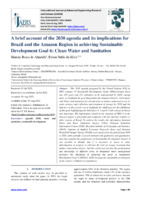 A BRIEF ACCOUNT OF THE 2030 AGENDA AND ITS IMPLICATIONS FOR BRAZIL AND THE AMAZON REGION IN ACHIEVING SUSTAINABLE DEVELOPMENT GOAL 6: CLEAN WATER AND SANITATION
A BRIEF ACCOUNT OF THE 2030 AGENDA AND ITS IMPLICATIONS FOR BRAZIL AND THE AMAZON REGION IN ACHIEVING SUSTAINABLE DEVELOPMENT GOAL 6: CLEAN WATER AND SANITATION The 2030 Agenda prepared by the United Nations (UN) in 2015 contains 17 Sustainable Development Goals (SDGs) broken down into 169 goals and 231 indicators to be implemented by 2030, among them, we highlight the goal Sustainable Development Goal 6: which deals with Water and sanitation for all and aims to achieve universal access to
water services and collection and treatment of sewage by 2030 and the objective of this article was to highlight the challenges for the fulfillment of this goal, highlighting the indicatives 6. 1 and 6.2 with a focus on Brazil and Amazonas. The information related to the situation of SDG 6 in the Amazon region is presented and compared with the national realities or other regions of Brazil. To achieve the results, the information National Water and Basic Sanitation Agency (ANA), National Sanitation Information System (SNIS), Brazilian Institute of Geography and Statistics (IBGE), Institute of Applied Economic Research (Ipea) and National Household Sample Survey (PNAD) were analyzed in the period from 2016 to 2020, with scientific research methods with qualitative and quantitative data that examine the performance of Sustainable Development Goal 6. It was possible to identify that it is necessary to invest in water infrastructure in projects to alleviate the lack of sewage treatment that bothers Amazonian citizens. And the conclusion was that the participation and knowledge of different areas in integrated water management increases the likelihood of achieving the goals of Sustainable Development Goal 6 (SDG) by 2030, because the sustainable development of the country is linked to its population.
-
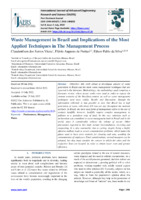 WASTE MANAGEMENT IN BRAZIL AND IMPLICATIONS OF THE MOST APPLIED TECHNIQUES IN THE MANAGEMENT PROCESS
WASTE MANAGEMENT IN BRAZIL AND IMPLICATIONS OF THE MOST APPLIED TECHNIQUES IN THE MANAGEMENT PROCESS This work aimed to investigate aspects of waste generation in Brazil and the main waste management techniques that are reported in the literature. Methodology: the methodology used comprises a literature review, where recent works were used in order to expose the current scenario of the Brazilian context, as well as waste management techniques used more widely. Results and Discussion: through the information collected, it was possible to note that Brazil has a high generation of waste, with about 216 tons per day throughout the national territory. In Brazil, the most used form of management refers to the use of sanitary landfills, however, landfills require complex management, in addition to a grandiose strip of land. In this way, solutions such as incineration can contribute to waste management both in Brazil and in the world, since it considerably reduces the volume of wa-ste. Other alternatives reported in this study include bioremediation, recycling and composting. It is also noteworthy that re-cycling, despite being a highly effective method, leads to severe contamination problems, which makes the plants need to have strict controls for cleaning and care, avoiding the contamination of employees. Final considerations: several measures can be adopted, but they must consider the context in which the cities and the respective State are located, in order to obtain lower costs and greater
efficiency.
-
 SUSTAINABLE DEVELOPMENT AND ENVIRONMENTAL EDUCATION IN THE DESSANA INDIAN VILLAGE, TUPÉ/MANAUS/ AM.
SUSTAINABLE DEVELOPMENT AND ENVIRONMENTAL EDUCATION IN THE DESSANA INDIAN VILLAGE, TUPÉ/MANAUS/ AM. This research has the theme sustainable development throughout environmental education, in the Dessana indian village, based in the Tupé community, in Manaus, Amazonas State. The aims were all focused on developing pedagogical proposals so that the Dessana Tupé-AM community indians get to know the theme of sustainable development and environmental education. It has been used, as methodology, on-site field research which showed the Dessana community inserted in a economic system, that determined social context amendments in this people, making possible service offering, such as turistics visits in village na on their territory, cultural presentations in resorts and in other turísticas spaces, craft selling, with the goal of preserve the culture, the traditional knowledge and sustainability. However, when it comes to environment preservation it is possible noticing that the indian village have not gain yet actions that inform about the existance of material that do not decompose naturally, as the organic products, something learnt with their ancestors experiences. Therefore, it urges Environmental Educational actions to avoid enviromental impacts. From this contexto on, it has been designed a pedagogical proposal with the insertion of a booklet that aims to demonstrate the enviroment education journey and development that intends to contribute with a learning process in a more significant way, for their own contextualization and recognition on the environment they are.
-
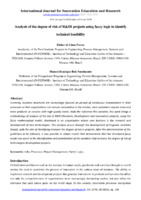 ANALYSIS OF THE DEGREE OF RISK OF R&DI PROJECTS USING FUZZY LOGIC TO IDENTIFY TECHNICAL FEASIBILITY
ANALYSIS OF THE DEGREE OF RISK OF R&DI PROJECTS USING FUZZY LOGIC TO IDENTIFY TECHNICAL FEASIBILITY Currently, business structures are increasingly focused on pursuit of continuous improvement in their processes so that organizations can remain competitive in the market, since customers require more and more products or services with high quality levels. With the reference this scenario, this work brings a methodology of analysis of the risk of R&DI (Research, Development and Innovation) projects, using the fuzzy mathematical model, developed in an organization whose core business is the research and development of new technologies. This analysis occurs through the development of linguistic variables (input), with the aim of identifying measure the degree of risk in projects. After the determination of the
guidelines to be followed, it was possible to obtain results that demonstrate that the developed fuzzy model can assist in the identification and prioritization of the variables that increase the degree of risk of technologies development projects.
-
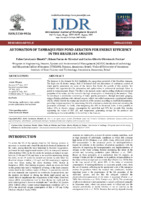 AUTOMATION OF TAMBAQUI FISH POND AERATION FOR ENERGY EFFICIENCY IN THE BRAZILIAN AMAZON
AUTOMATION OF TAMBAQUI FISH POND AERATION FOR ENERGY EFFICIENCY IN THE BRAZILIAN AMAZON The increase in the demand for fish highlights the aquaculture potential of the Brazilian Amazon.The high cost of electric energy, lack of technical staff and inexistence of continuous control ofwater quality parameters are some of the factorsthat hinder the growth of this activity. We evaluated two opportunities for automation and optimization in commercial tambaqui farms in ponds in Amazonasstate, Brazil. The first is the manual control and recording of physical-chemical properties of the water, and the second is the high consumption of electricity by the aerators. Thus, we developed a continuous monitoring of water quality parameters, through automatic gauging, using a floating platform with onboard sensors, which was called autonomous experimental station (AES), which controls the startup and shutdown of the aerators according to established parameters, providing oxygen necessary for maintaining fish life, eliminating electricity waste and recording the parameters evaluated. As result, after integrating the AES in excavated tanks, it was possible to reduce 26% in electric energy consumption for adult fish and 52% for juvenile fish, besides
registering the values of DO, pH, and temperature, generating savings for the producer and contributing to the sustainability of the activity in the Amazon.
-
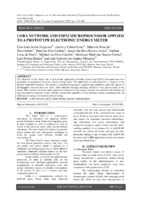 LORA NETWORK AND ESP32 MICROPROCESSOR APPLIED TOA PROTOTYPE ELECTRONIC ENERGY METER
LORA NETWORK AND ESP32 MICROPROCESSOR APPLIED TOA PROTOTYPE ELECTRONIC ENERGY METER The objective of this article was to discuss the application of LoRa network and ESP32 microprocessor in a prototype of a polyphase electronic electric energy meter. The application was developed for a company in the Manaus Industrial Complex. The article is considered exploratory, applied and qualitative under the aspects of bibliographic research and case study. Data collected through meetings, technical visits and research on the theme. The evolution of smart meters generates innovation to the energy network and optimizes the reading and data recorded by electronic meters. Results showed the capability of long-distance remote communication and efficiency in energy consumption data recording.
-
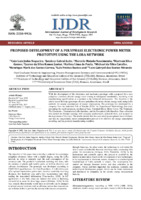 PROPOSED DEVELOPMENT OF A POLYPHASE ELECTRONIC POWER METER PROTOTYPE USING THE LORA NETWORK
PROPOSED DEVELOPMENT OF A POLYPHASE ELECTRONIC POWER METER PROTOTYPE USING THE LORA NETWORK With the development of the electronics and mechanics prototype with a proposal for a new polyphase electronic electric energy meter aiming at subsequent manufacture, according to its manufacturing specifications as a product in the industrial environment. The objective of the article was to develop a prototype of a new polyphase electronic electric energy meter using LoRa network, for remote measurement of energy consumption. The prototype was developed for a company from the Industrial Pole of Manaus (PIM). An Experimental Methodology was used, presenting the model proposal, mechanical base, Terminal Block, Meter Cover, The Terminals, The Electronics, Transmission LoRa Interface, and the Reception LoRa Interface. Data collection was carried out through meetings with company professionals, technical visits, and research on the importance of the topic. The results showed that the main development phases were validated, and that the long-distance meter communication proved to be effective for energy consumption recording, and has potential manufacturing condition.
-
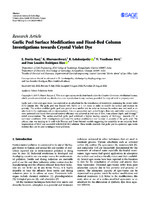 Garlic Peel Surface Modification and Fixed-Bed Column Investigations towards Crystal Violet Dye
Garlic Peel Surface Modification and Fixed-Bed Column Investigations towards Crystal Violet Dye Garlic peel, a low-cost agro-waste, was explored as an adsorbent for the remediation of wastewater containing the crystal violet (CV) cationic dye. The garlic peel was treated with NaOH at 1 : 1.5 ratios in order to modify the surface and increase its porosity. The surface-modified garlic peel was ground to a smaller size in order to increase its surface area and used as an adsorbent in the continuous column investigations. Column parameters such as bed height, flow rate, and initial concentration were optimised and found that optimal removal efficiency was achieved at 3 ml rate of flow, 3 cm column depth, and 100 mg l-1 initial concentration. The surface-modified garlic peel exhibited a higher loading capacity of 99.9 mg g-1 towards CV at optimised conditions. SEM investigations confirmed the surface modification and increase in porosity of the garlic peel. The column data was tending to fit well with Thomas and Yoon-Nelson’s models suggesting the scalability to an industrial level. Regeneration of MGP was successful with 0.01 M HCl solution. These results conclude that garlic peel is a potential agro-waste material that can be used to mitigate water pollution
-
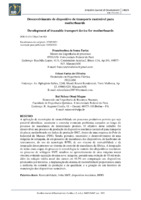 DEVELOPMENT OF TRACEABLE TRANSPORT DEVICE FOR MOTHERBOARDS
DEVELOPMENT OF TRACEABLE TRANSPORT DEVICE FOR MOTHERBOARDS The application of traceability technologies in production processes makes it possible to identify, monitor and control any problems caused during the manufacturing process of a given product. The objective of this work was to develop a process of producing a traceable mechanical device to transport motherboards on SMT production lines, within
a company of the Manaus Industrial Pole (PIM). Therefore, it is necessary to develop a machining machine, a device manufacturing process, tracking hardware, the use of RFID technology, a traceability system and the integration of this process into the factory manufacturing control system. The integration of all these process steps with the
mechanical device tracking methodology in the SMT welding process resulted in the use of an obsolete router machine avoiding the acquisition of a new machine, generating a reduction of 24 thousand dollars, besides the annual average reduction of the 49.5% compared to devices produced by third parties, the implementation of the traceability
system has also improved production and quality control, and the generation of a trackable device maintenance history
-
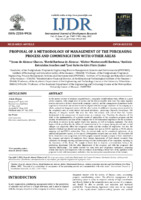 PROPOSAL OF A METHODOLOGY OF MANAGEMENT OF THE PURCHASING PROCESS AND COMMUNICATION WITH OTHER AREAS
PROPOSAL OF A METHODOLOGY OF MANAGEMENT OF THE PURCHASING PROCESS AND COMMUNICATION WITH OTHER AREAS In the current context of extreme competitiveness, companies should redirect their efforts to a good service capacity, with a high level of service and the lowest possible total cost. The entire logistics process represents a decisive factor in the company's activity, and the management of purchases in the acquisition of materials and services should be aligned with the strategic objectives of the company as a whole, acting in an integrated manner with the other sectors, in addition to exposing actions guarded by the compliance area to avoid ethical and moral deviations, protecting Corporate Governance. The adequacy of integrity models that meet the rules that comply with current laws has become fundamental in the management of organizations as a strategic way. Therefore, the objective of this study is the implementation of a process model of application of the compliance program and the security of information and data of the company that is of fundamental importance for the acceptance of products or services in the market where they operate, as well as business continuity. The study began with the problem that the failure of communication in the company during internal and external changes can negatively affect the company's results and the conduct of employees. For this, the Inductive Method was elected and thus used a strategic tool such as SWOT analysis, a 5W2H activity mapping tool and PDCA action plan. Thus, the present study can be considered exploratory, of an applied and qualitative nature, in two aspects, bibliographic research and case study. The Research will be by observation and comparison with bibliographic research through a sample of facts identified in the company and reports of employees from various departments, of facts already occurred. Data collection was through meeting and interviewing with the professionals of the companies, reporting on the importance of the theme. We sought to know how to improve communication between the purchasing department with the other departments of the company and with the companies that maintain relationships. The results showed the main tools and compliance mechanism, proposing actions that can be used in practice with the purpose of providing a broad view of the operation of the proposed model, with transparency and ethics, thus increasing the competitiveness of the business.
-
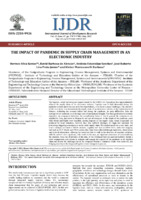 THE IMPACT OF PANDEMIC IN SUPPLY CHAIN MANAGEMENT IN AN ELECTRONIC INDUSTRY
THE IMPACT OF PANDEMIC IN SUPPLY CHAIN MANAGEMENT IN AN ELECTRONIC INDUSTRY The logistics, social and economic impact caused by the SARS-CoV-2 pandemic has unprecedentedly affected the supply chain of the electronics industry. Logistics was in high demanded during this pandemic period, and it was key actor for chain balance, even faced so many challenges. The objective of this case study is to demonstrate the supply chain of an electronics industry in the industrial pole of Manaus, evaluating the scenario before and during the pandemic, its main difficulties, from the shortage of raw materials up to the high costs of international freights. The final good industry is totally dependent on component industries, the complicating factor is that in general the components are supplied by Asia, and arrive in Manaus by sea and air transport. At the height of the pandemic, ports were closed and flights were canceled, causing impacts on the supply chain. Some components are produced by local industries, however they also suffered shortages of virgin raw materials for processing, triggering consequences on the entire supply chain. The method used was a case study, and used a strategic tool such as SWOT analysis, a quality tool such as ISHIKAWA, and a risk mapping tool such as GUT Matrix and 5W2H action plan. Data were collected through interviews, observations and archival information, allowing the researcher free to walk in the direction of construct solutions, with the author's own experience, who works in the area, an important component of contextualizing the research. From the observation of the data, it was evidenced that the analyzed industry started a crisis management, and actions to mitigate and manage the impacts of the pandemic on its logistics chain and despite the challenges faced, the company's business continuity results were achieved, and bringing maturity to the integrated logistics chain management process.
-
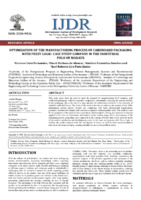 OPTIMIZATION OF THE MANUFACTURING PROCESS OF CARDBOARD PACKAGING WITH FUZZY LOGIC: CASE STUDY COMPANY IN THE INDUSTRIAL POLO OF MANAUS
OPTIMIZATION OF THE MANUFACTURING PROCESS OF CARDBOARD PACKAGING WITH FUZZY LOGIC: CASE STUDY COMPANY IN THE INDUSTRIAL POLO OF MANAUS This study arose from the need to meet the demand for manufacturing LCD monitors with cardboard packaging, with less assembly complexity, substantially reducing the amount of folds in the packaging, due to the use of a large number of collaborators involved in the assembly of standard cardboard boxes. The focus of the work is directly on reducing the amount of box folds, maintaining current factory layouts and complying with basic dimensional requirements, geometry, mechanical strength, and customer acceptance criteria (quality tests). The methods used for the purposes of the research were exploratory and descriptive, having as a research instrument applied in the form of observation and analysis in the various stages of the development of the packaging project, proposing a new approach to the concept of boxes that would meet the needs of the modern production and development needs. In this case, we propose, with Fuzzy logic, to validate the results obtained with the new layouts of boxes, as well as other recommendations relevant to the proposed study, creating subsidies to answer the problem raised
-
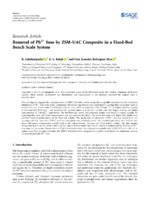 Removal of Pb2+ Ions by ZSM-5/AC Composite in a Fixed-Bed Bench Scale System
Removal of Pb2+ Ions by ZSM-5/AC Composite in a Fixed-Bed Bench Scale System This investigation suggests the implementation of ZSM-5 activated carbon composite as a prolific adsorbent for the continuous elimination of Pb2+ ions from water. Continuous adsorption experiments were performed by varying three parameters such as process flow rate (2-6 mL min-1), bed height (2-6 cm), and initial concentration (250–750 mg L-1). The highest loading capacity of the fixed-bed 213.3 mg L-1 was achieved with optimal values of 2 mL min-1 of flow rate, bed height of 6 cm, and initial concentration of 750 mg L-1, respectively. The breakthrough curves and saturation points were found to appear quickly for increasing flow rates and initial concentration and vice versa for bed depth. The lower flow rates with higher bed depths have exhibited optimal performances of the fixed-bed column. The mechanism of adsorption of Pb2+ ions was found to be ion exchange with Na+ ions from ZMS-5 and pore adsorption onto activated carbon. The breakthrough curves were verified with three well-known mathematical models such as the Adams-Bohart, Thomas, and Yoon-Nelson models. The later models showed the best fit to the column data over the Adams-Bohart model that can be utilized to understand the binding of Pb2+ ions onto the composite. Regeneration of ZSM-5/activated carbon was achieved successfully with 0.1 M HCl within 60 min of contact time. The outcomes conclude that ZSM-5 activated carbon composite is a prolific material for the continuous removal of water loaded with Pb2+ ions
-
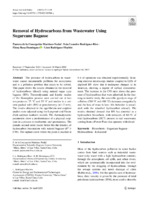 Removal of Hydrocarbons from Wastewater Using Sugarcane Bagasse
Removal of Hydrocarbons from Wastewater Using Sugarcane Bagasse The presence of hydrocarbons in wastewater causes innumerable problems for ecosystems
and is a pollution problem that needs to be solved. This paper shows the results obtained in the removal of hydrocarbons (diesel) using natural sugar cane bagasse (BN). Thermodynamic and kinetic studies of the biosorption process were carried out at two temperatures: 25 °C and 35 °C and studies in a column packed with (BN) at granulometry (+1–2 mm). The results obtained in the equilibrium and sorption studies were adjusted using the Langmuir and Freundlich sorption isotherm models. The thermodynamic parameters show a predominance of a physical sorption; in a process is exothermic and spontaneous. The pseudo second-order model better fts the kinetics of hydrocarbon biosorption with natural bagasse (R2 ≥ 0.98). The rupture curve where the point is reached 6 h of operation was obtained experimentally. Scanning electron microscopy studies coupled to EDX of depleted BN show that it undergoes changes in its structure, showing a degree of surface dismemberment. The increase in the C/O ratio shows the presence of hydrocarbons that were adsorbed. In the thermogravimetric study, the anaerobic pyrolysis stage of cellulose (200 °C and 400 °C) decreases energetically and the loss of mass is less; this behavior is associated with the adsorbed hydrocarbon (diesel). The results obtained showed that BN has potential as a hydrocarbon biosorbent, with removals of 60.3% of total hydrocarbons (HCT) present in real wastewater, coming from a Power Plant that operates with diesel .
 LOGISTICS MANAGEMENT FOR SUPPLIER EVALUATION IN AN INDUSTRY USING ARTIFICIAL INTELLIGENCE (FUZZY LOGIC) FOR DECISION MAKING Today's quality is an indispensable requirement when it comes to the production of products or services, because with the highly competitive market, a simple factor that does not please the consumer, can be crucial to generate negative points in business operations. With this, the research carried out in a watch factory X, served to analyze the factors that contribute to the performance and analysis of an international supplier in the year 2019 and 2020, and to reach this objective it was necessary to raise the rejected parts indicators in the process of inspection of receiving process and assembly, as well as the rejection replacement service deadline process in order to evaluate the supplier's performance. The need to carry out this analysis, arose through the experience of one of the members of the group, who works at the company, therefore, this article may contribute to maximize the managers' decision making regarding the approval or disqualification of suppliers to produce watches. A quantitative approach, aiming to measure the variables, the procedure for data collection was through excel spreadsheet documents compiled from the SAP program. At the end of this research, improvement actions were suggested for the company according to the application of the supplier evaluation by the fuzzy logic method. The results achieved in this article, aim to work on the evaluation method and thus try to reduce the losses that generate losses with the process of waiting for information to be collected for decision making.
LOGISTICS MANAGEMENT FOR SUPPLIER EVALUATION IN AN INDUSTRY USING ARTIFICIAL INTELLIGENCE (FUZZY LOGIC) FOR DECISION MAKING Today's quality is an indispensable requirement when it comes to the production of products or services, because with the highly competitive market, a simple factor that does not please the consumer, can be crucial to generate negative points in business operations. With this, the research carried out in a watch factory X, served to analyze the factors that contribute to the performance and analysis of an international supplier in the year 2019 and 2020, and to reach this objective it was necessary to raise the rejected parts indicators in the process of inspection of receiving process and assembly, as well as the rejection replacement service deadline process in order to evaluate the supplier's performance. The need to carry out this analysis, arose through the experience of one of the members of the group, who works at the company, therefore, this article may contribute to maximize the managers' decision making regarding the approval or disqualification of suppliers to produce watches. A quantitative approach, aiming to measure the variables, the procedure for data collection was through excel spreadsheet documents compiled from the SAP program. At the end of this research, improvement actions were suggested for the company according to the application of the supplier evaluation by the fuzzy logic method. The results achieved in this article, aim to work on the evaluation method and thus try to reduce the losses that generate losses with the process of waiting for information to be collected for decision making. THE IMPORTANCE OF THE ENVIRONMENT IN EVERYDAY SCHOOL LIFE: WORKING WITH DEAF STUDENTS USING ACTIVE METHODOLOGIES It is relevant that the study presented presents an analysis of the main methodologies used in the education of students that emerged in Elementary School, having as a model the theme, The Environment in School Daily Life and its Active Methodologies. The study aims to evaluate the results by the capacity of the students acquired Environment in the Daily School Life of these deaf students, through active methodologies. The student is encouraged to take an active and responsible stance in their learning process, seeking selfregulation and meaningful learning. Learning methods and techniques that stimulate student-teacher and student-student interaction, teaching materials and resources and handouts, almost always, in collaborative learning, taking the student to be responsible for the construction of their knowledge. Based on this premise, we will present a qualitative research and significant results. Expand our information through field research by observation studies and studies, expanding experiences with students emerging from a state school in Manaus. Therefore, we will present some methodologies, among which are Recycle, Reuse and Reduce solid waste. It was found that the methodologies used are oriented according to child-centered learning theories. In this investment in the deaf and their registration, student, context, thus, the service to useful services for stimulation and development is essential. Based on the evaluation of the results by the applicability of the environment themes obtained in the school routine, and the uses of active methodologies, to propose a new method of study to train deaf students. We will seek the best way to work as methodologies in the training of the deaf subject. It was verified the use of the methodologies that motivate the use of the methodologies that motivate the use of their disks and the direction of solutions to make an impasse and promote their development, which is an adequate and necessary instrument for a new learning. It is concluded that the teaching and learning process with deaf students still lacks research opportunities aimed at the adoption of new techniques that favor learning at better levels of qualification for the child.
THE IMPORTANCE OF THE ENVIRONMENT IN EVERYDAY SCHOOL LIFE: WORKING WITH DEAF STUDENTS USING ACTIVE METHODOLOGIES It is relevant that the study presented presents an analysis of the main methodologies used in the education of students that emerged in Elementary School, having as a model the theme, The Environment in School Daily Life and its Active Methodologies. The study aims to evaluate the results by the capacity of the students acquired Environment in the Daily School Life of these deaf students, through active methodologies. The student is encouraged to take an active and responsible stance in their learning process, seeking selfregulation and meaningful learning. Learning methods and techniques that stimulate student-teacher and student-student interaction, teaching materials and resources and handouts, almost always, in collaborative learning, taking the student to be responsible for the construction of their knowledge. Based on this premise, we will present a qualitative research and significant results. Expand our information through field research by observation studies and studies, expanding experiences with students emerging from a state school in Manaus. Therefore, we will present some methodologies, among which are Recycle, Reuse and Reduce solid waste. It was found that the methodologies used are oriented according to child-centered learning theories. In this investment in the deaf and their registration, student, context, thus, the service to useful services for stimulation and development is essential. Based on the evaluation of the results by the applicability of the environment themes obtained in the school routine, and the uses of active methodologies, to propose a new method of study to train deaf students. We will seek the best way to work as methodologies in the training of the deaf subject. It was verified the use of the methodologies that motivate the use of the methodologies that motivate the use of their disks and the direction of solutions to make an impasse and promote their development, which is an adequate and necessary instrument for a new learning. It is concluded that the teaching and learning process with deaf students still lacks research opportunities aimed at the adoption of new techniques that favor learning at better levels of qualification for the child. REDUCTION OF SUGAR LOSS USING LEAN SIX SIGMA TOOLS AND DMAIC METHOD TO INCREASE COMPETITIVENESS AND REDUCE COSTS IN A SOFT DRINK COMPANY The Lean Six Sigma method is the integration between Lean Manufacturing and Six Sigma, two methods that have been adding value to the productive processes, generating the best results, because they provide tools to assist in the management of the indicators of the companies that use them. The use of this method in the manufacturing process is a strategic factor for the competitive companies, whose focus seeks to meet the customers with an appropriate cost to the market requirements, considering that the existing processes related to the manufacture of a finished product have their variability. Objective: This study aimed to present the application of Lean Six Sigma tools, describe the use of the DMAIC model and demonstrate its application in the process of syrup and filling of beverage in one of the companies of Simões Group, as well as demonstrate the results obtained with the reduction of production cost by reducing the loss of sugar. Methodology: The technique applied in this study followed the steps of DMAIC methodology, where statistical tools were used to DEFINE the objective, the scope and the main steps of the project and to delimit the problem, to MEASURE the current performance of the process and to reduce the problem area, to ANALYZE the potential root causes and confirm them with data to determine the opportunities for improvement, to IMPLEMENT the process improvements by developing and testing solutions that address the root causes and finally to CONTROL the processes to maintain the gains and the transition to full implementation. Result/Discussion: This project had a team that applying VOC methodologies - Voice of Customer, identification of the Critical Attributes for the Quality of the customer - CTQs (Critical to Quality), Serpent Diagram and SIPOC, were able to collect with the internal customers information about the processes of manufacturing of simple syrup, final syrup and filling of drinks in PET bottles, as well as others related to the theme. Conclusion: It was possible to determine and quantify the main process wastes after the total implementation of the actions proposed by the six sigma team, having reached the objective of this project. By comparing the sugar loss with the previous period measured, the analyzed process reduced the average percentage of losses from 2.02% to 0.07% after the implemented actions. Thus, there was a financial contribution of the project to the company with the average annual production cost reduction on sugar waste from $26,056 to $862, resulting in a loss reduction of $25,194 for the company.
REDUCTION OF SUGAR LOSS USING LEAN SIX SIGMA TOOLS AND DMAIC METHOD TO INCREASE COMPETITIVENESS AND REDUCE COSTS IN A SOFT DRINK COMPANY The Lean Six Sigma method is the integration between Lean Manufacturing and Six Sigma, two methods that have been adding value to the productive processes, generating the best results, because they provide tools to assist in the management of the indicators of the companies that use them. The use of this method in the manufacturing process is a strategic factor for the competitive companies, whose focus seeks to meet the customers with an appropriate cost to the market requirements, considering that the existing processes related to the manufacture of a finished product have their variability. Objective: This study aimed to present the application of Lean Six Sigma tools, describe the use of the DMAIC model and demonstrate its application in the process of syrup and filling of beverage in one of the companies of Simões Group, as well as demonstrate the results obtained with the reduction of production cost by reducing the loss of sugar. Methodology: The technique applied in this study followed the steps of DMAIC methodology, where statistical tools were used to DEFINE the objective, the scope and the main steps of the project and to delimit the problem, to MEASURE the current performance of the process and to reduce the problem area, to ANALYZE the potential root causes and confirm them with data to determine the opportunities for improvement, to IMPLEMENT the process improvements by developing and testing solutions that address the root causes and finally to CONTROL the processes to maintain the gains and the transition to full implementation. Result/Discussion: This project had a team that applying VOC methodologies - Voice of Customer, identification of the Critical Attributes for the Quality of the customer - CTQs (Critical to Quality), Serpent Diagram and SIPOC, were able to collect with the internal customers information about the processes of manufacturing of simple syrup, final syrup and filling of drinks in PET bottles, as well as others related to the theme. Conclusion: It was possible to determine and quantify the main process wastes after the total implementation of the actions proposed by the six sigma team, having reached the objective of this project. By comparing the sugar loss with the previous period measured, the analyzed process reduced the average percentage of losses from 2.02% to 0.07% after the implemented actions. Thus, there was a financial contribution of the project to the company with the average annual production cost reduction on sugar waste from $26,056 to $862, resulting in a loss reduction of $25,194 for the company. DEVELOPMENT OF A COMPARATIVE STUDY BETWEEN LINEAR REGRESSION AND DECISION TREE TECHNIQUES FOR 3rd HARMONIC A comparative study was carried out between the Simple Linear Regression and Decision Tree techniques in the evaluation of the impacts caused by the generation of harmonics, in the distribution network, in a medium voltage substation. Data collection was carried out through a measurement campaign in a 13.8 kV substation that feeds a portion of the companies in the industrial district of the city of Manaus. The objective of this dissertation is to carry out a comparative study of the results of the application of Decision Tree and Simple Linear Regression techniques in the analysis of harmonic impacts in an electrical system. The measurement campaign was carried out for a minimum period of 7 calendar days according to PRODIST. The impact of these harmonics on the electrical system is quite harmful, both for consumers and for utilities. The techniques used in the methodology of this dissertation are the Decision Tree technique, which features the construction of non-parametric models and the Simple Linear Regression technique, which features the construction of parametric models and simple mathematical calculation, easy to interpret and analyze. of data. In this way, this dissertation presented and applied in practice with case studies actions for the analysis of harmonic impacts in electrical energy distribution systems through the construction of mathematical models using Simple Linear Regression analysis and Regression Tree analysis, obtaining important and enlightening results. in the studies carried out, thus validating the techniques applied in the analysis of harmonic impacts in electrical energy distribution systems.
DEVELOPMENT OF A COMPARATIVE STUDY BETWEEN LINEAR REGRESSION AND DECISION TREE TECHNIQUES FOR 3rd HARMONIC A comparative study was carried out between the Simple Linear Regression and Decision Tree techniques in the evaluation of the impacts caused by the generation of harmonics, in the distribution network, in a medium voltage substation. Data collection was carried out through a measurement campaign in a 13.8 kV substation that feeds a portion of the companies in the industrial district of the city of Manaus. The objective of this dissertation is to carry out a comparative study of the results of the application of Decision Tree and Simple Linear Regression techniques in the analysis of harmonic impacts in an electrical system. The measurement campaign was carried out for a minimum period of 7 calendar days according to PRODIST. The impact of these harmonics on the electrical system is quite harmful, both for consumers and for utilities. The techniques used in the methodology of this dissertation are the Decision Tree technique, which features the construction of non-parametric models and the Simple Linear Regression technique, which features the construction of parametric models and simple mathematical calculation, easy to interpret and analyze. of data. In this way, this dissertation presented and applied in practice with case studies actions for the analysis of harmonic impacts in electrical energy distribution systems through the construction of mathematical models using Simple Linear Regression analysis and Regression Tree analysis, obtaining important and enlightening results. in the studies carried out, thus validating the techniques applied in the analysis of harmonic impacts in electrical energy distribution systems. USE OF FLEXSIM TO SIMULATE IMPROVEMENT PROPOSALS IN A REMOTE CONTROL PRODUCTION LINE Computational simulation is a tool with the potential to generate a large reduction in operating costs, since it is possible to model a process in a controllable environment, test modifications and analyze the results, without necessarily changing the actual structure of the production process. In this article, it was sought to propose productive scenarios through simulation that aims to eliminate the presence of non-compliant products due to the use of flux NC215 in the wave soldering process and to increase the productive capacity for production of remote controls in a company located in the Industrial Pole of Manaus/AM, identify the best proposed scenario from the use of computer simulation with Flexsim software. Data was collected regarding the current production process. The computational model built, was verified and validated successfully in comparison with data from the real process. Through the results obtained by the computational simulation it was possible to identify the best proposed scenario.
USE OF FLEXSIM TO SIMULATE IMPROVEMENT PROPOSALS IN A REMOTE CONTROL PRODUCTION LINE Computational simulation is a tool with the potential to generate a large reduction in operating costs, since it is possible to model a process in a controllable environment, test modifications and analyze the results, without necessarily changing the actual structure of the production process. In this article, it was sought to propose productive scenarios through simulation that aims to eliminate the presence of non-compliant products due to the use of flux NC215 in the wave soldering process and to increase the productive capacity for production of remote controls in a company located in the Industrial Pole of Manaus/AM, identify the best proposed scenario from the use of computer simulation with Flexsim software. Data was collected regarding the current production process. The computational model built, was verified and validated successfully in comparison with data from the real process. Through the results obtained by the computational simulation it was possible to identify the best proposed scenario. APPLICATION OF THE SIX SIGMA METHODOLOGY AND USE OF THE DMAIC METHOD TO REDUCE THE LOSS RATE OF ALUMINIUM CANS IN A BEVERAGE INDUSTRY TO REDUCE OPERATIONAL COSTS: CASE STUDY: LATAX REFRIGERANTES LTDA Introduction: Six Sigma is an internationally recognized tool widely used in the identification and implementation of improvements in internal processes of an organization, aiming to obtain lower operating costs and, consequently, increase profit margins. During the application of this tool it is necessary to follow a defined sequence of steps and to establish quantified objectives. Objective: This study demonstrates how the application of the tool can assist in reducing operational costs by reducing losses of cans in the production process through cause analysis and implementation of action plans in a production line of soft drinks in aluminum cans in a beverage industry. Methodology: In the application of this study, steps of the DMAIC methodology were followed, where statistics tools were used to DEFINE the problems and identify the improvements, MEASURE during the phases of getting results, ANALYZE the collected data into useful information for decision making, IMPLEMENT the actions proposed in an action plan based on the previous steps and finally CONTROL the processes so that continuous improvement is a living cycle within the institution. Result/Discussion: The six sigma team of this project, applying VOC - Voice of Customer, Snake Diagram and SIPOC methodologies, could interact with internal customers about the soft drink bottling processes in aluminium cans, as well as the other processes that interact among themselves and how this industrialization process is inserted in the context of the organization as a whole. Conclusion: After the full implementation of the actions proposed by the six sigma team of this project, the objective was met. In comparison with the previous measured period, the analyzed process reduced the average percentage of can losses from 0.53% to 0.26% after the implemented actions. Thus, the financial contribution of the project to the company was an average annual operating cost reduction on aluminum can waste from $13,596 to $6,670, resulting in a loss reduction of $6,926 for the company.
APPLICATION OF THE SIX SIGMA METHODOLOGY AND USE OF THE DMAIC METHOD TO REDUCE THE LOSS RATE OF ALUMINIUM CANS IN A BEVERAGE INDUSTRY TO REDUCE OPERATIONAL COSTS: CASE STUDY: LATAX REFRIGERANTES LTDA Introduction: Six Sigma is an internationally recognized tool widely used in the identification and implementation of improvements in internal processes of an organization, aiming to obtain lower operating costs and, consequently, increase profit margins. During the application of this tool it is necessary to follow a defined sequence of steps and to establish quantified objectives. Objective: This study demonstrates how the application of the tool can assist in reducing operational costs by reducing losses of cans in the production process through cause analysis and implementation of action plans in a production line of soft drinks in aluminum cans in a beverage industry. Methodology: In the application of this study, steps of the DMAIC methodology were followed, where statistics tools were used to DEFINE the problems and identify the improvements, MEASURE during the phases of getting results, ANALYZE the collected data into useful information for decision making, IMPLEMENT the actions proposed in an action plan based on the previous steps and finally CONTROL the processes so that continuous improvement is a living cycle within the institution. Result/Discussion: The six sigma team of this project, applying VOC - Voice of Customer, Snake Diagram and SIPOC methodologies, could interact with internal customers about the soft drink bottling processes in aluminium cans, as well as the other processes that interact among themselves and how this industrialization process is inserted in the context of the organization as a whole. Conclusion: After the full implementation of the actions proposed by the six sigma team of this project, the objective was met. In comparison with the previous measured period, the analyzed process reduced the average percentage of can losses from 0.53% to 0.26% after the implemented actions. Thus, the financial contribution of the project to the company was an average annual operating cost reduction on aluminum can waste from $13,596 to $6,670, resulting in a loss reduction of $6,926 for the company. METHODOLOGY FOR PHOTOVOLTAIC PLANT MODELING WITH RETSCREEN SOFTWARE APPLICATION In today's world, the search for new energy generation alternatives is increasing and being far from large metropolitan centers is an aggravating factor for the socioeconomic development of municipalities. In addition to the difficulty and high costs of keeping a city in proper working order, the quality of service provided by electricity concessionaires has low efficiency and high consumption of fossil fuels. In order to contribute to a solution, this work aims to present an alternative developed using the RETScreen Software, through the design of a photovoltaic plant, to meet the energy demands of the municipalities in the state of Amazonas. Through the research, we sought to understand and present the particularities of each proposed chapter and, through computer simulation, to develop a renewable source plant to supply the demand of the municipality of São Gabriel da Cachoeira-AM. Two possibilities of application of the result can be analyzed, where the fulfillment of the demand was carried out in a total and partial way and, with that, obtain satisfactory results such as the reduction of 50% of the consumption of fossil fuel, reduction of 25% to 50 % of emission of polluting gases and to present the potential that the generation of photovoltaic energy has for the Amazon region
METHODOLOGY FOR PHOTOVOLTAIC PLANT MODELING WITH RETSCREEN SOFTWARE APPLICATION In today's world, the search for new energy generation alternatives is increasing and being far from large metropolitan centers is an aggravating factor for the socioeconomic development of municipalities. In addition to the difficulty and high costs of keeping a city in proper working order, the quality of service provided by electricity concessionaires has low efficiency and high consumption of fossil fuels. In order to contribute to a solution, this work aims to present an alternative developed using the RETScreen Software, through the design of a photovoltaic plant, to meet the energy demands of the municipalities in the state of Amazonas. Through the research, we sought to understand and present the particularities of each proposed chapter and, through computer simulation, to develop a renewable source plant to supply the demand of the municipality of São Gabriel da Cachoeira-AM. Two possibilities of application of the result can be analyzed, where the fulfillment of the demand was carried out in a total and partial way and, with that, obtain satisfactory results such as the reduction of 50% of the consumption of fossil fuel, reduction of 25% to 50 % of emission of polluting gases and to present the potential that the generation of photovoltaic energy has for the Amazon region PROFILE OF STATE AND MUNICIPAL SCHOOLS IN THE MUNICIPALITY OF ITACOATIARA: ENVIRONMENTAL EDUCATION CONTEXT The natural environment is essential to life because it is through it that it is possible to extract resources for living beings that are inserted in it. For this, a balance of living beings and the environment is necessary through environmental awareness. The research objectives are to obtain the profile of the analyzed schools, observing how EE is applied in the public network of the municipality, in order to create a manual of practices of applicability of Environmental Education in schools. The research was carried out in thirteen public schools in the city of Itacoatiara/Am. Authorizations were obtained for the visits, observing how the theme is applied in schools and whether they have environmental projects. After the visits, an online questionnaire was applied to teachers and students to detect the qualities and deficiencies of the schools. Finally, the profile of the schools was obtained in order to develop an interdisciplinary application manual in schools in the Amazon. As a result, it was found that public schools are more prepared to work on these themes, and in support of pedagogical resources, given the lack of municipal schools, which, in addition to the lack of material, do not have the application of environmental projects as in state schools in that all apply at least one. All teachers are interested in working in an interdisciplinary way, as the topics are only worked in the classroom and according to the students' results, they are not attractive. It is concluded that there are many deficiencies that need to be corrected, be they structural, pedagogical and material that could benefit the teaching of EE, and thus, make the practices more attractive to the students.
PROFILE OF STATE AND MUNICIPAL SCHOOLS IN THE MUNICIPALITY OF ITACOATIARA: ENVIRONMENTAL EDUCATION CONTEXT The natural environment is essential to life because it is through it that it is possible to extract resources for living beings that are inserted in it. For this, a balance of living beings and the environment is necessary through environmental awareness. The research objectives are to obtain the profile of the analyzed schools, observing how EE is applied in the public network of the municipality, in order to create a manual of practices of applicability of Environmental Education in schools. The research was carried out in thirteen public schools in the city of Itacoatiara/Am. Authorizations were obtained for the visits, observing how the theme is applied in schools and whether they have environmental projects. After the visits, an online questionnaire was applied to teachers and students to detect the qualities and deficiencies of the schools. Finally, the profile of the schools was obtained in order to develop an interdisciplinary application manual in schools in the Amazon. As a result, it was found that public schools are more prepared to work on these themes, and in support of pedagogical resources, given the lack of municipal schools, which, in addition to the lack of material, do not have the application of environmental projects as in state schools in that all apply at least one. All teachers are interested in working in an interdisciplinary way, as the topics are only worked in the classroom and according to the students' results, they are not attractive. It is concluded that there are many deficiencies that need to be corrected, be they structural, pedagogical and material that could benefit the teaching of EE, and thus, make the practices more attractive to the students. OS IMPACTOS ECONÔMICOS E SOCIAIS DA REPAVIMENTAÇÃO DA BR 319 E SEUS RESPECTIVOS DESDOBRAMENTOS AMBIENTAIS. BR 319 is a highway of great importance for the state of Amazonas and for other states in the northern region, since the existence of this road directly influences social, economic and environmental aspects of the region. It is noteworthy that many people depend on this highway to move between Manaus and Porto Velho and, consequently, to connect to the rest of the country. This study presents an analysis of the economic and social benefits of the repaving of BR 319 and its respective environmental consequences. On a preliminary basis, it can be said that the reconstruction of the road will contribute to the increase in the generation of jobs and will facilitate the flow of production, favoring regional development. This study also suggests that the reconstruction of the road will result in a reduction in the cost per kilometer traveled, resulting in a decrease in road freight and a reduction in the value of bus tickets between Manaus and Porto Velho. The loss, degradation of natural habitats, fauna trampling, chemical pollution, anthropic invasion and the increase in violence were some of the negative impacts raised in this work.
OS IMPACTOS ECONÔMICOS E SOCIAIS DA REPAVIMENTAÇÃO DA BR 319 E SEUS RESPECTIVOS DESDOBRAMENTOS AMBIENTAIS. BR 319 is a highway of great importance for the state of Amazonas and for other states in the northern region, since the existence of this road directly influences social, economic and environmental aspects of the region. It is noteworthy that many people depend on this highway to move between Manaus and Porto Velho and, consequently, to connect to the rest of the country. This study presents an analysis of the economic and social benefits of the repaving of BR 319 and its respective environmental consequences. On a preliminary basis, it can be said that the reconstruction of the road will contribute to the increase in the generation of jobs and will facilitate the flow of production, favoring regional development. This study also suggests that the reconstruction of the road will result in a reduction in the cost per kilometer traveled, resulting in a decrease in road freight and a reduction in the value of bus tickets between Manaus and Porto Velho. The loss, degradation of natural habitats, fauna trampling, chemical pollution, anthropic invasion and the increase in violence were some of the negative impacts raised in this work. THE LOGISTICAL CHALLENGES TO IMPLEMENT THE ENVIRONMENTAL MANAGEMENT SYSTEM IN A NATURAL GAS COMPANY IN THE NORTH REGION The implementation of the environmental management system (EMS) in large companies arises from the need to standardize operations and reduce environmental impacts. The general objective of the study is to develop a protocol for an environmental management system based on ISO 14001 standards in a natural gas company in the region of Amazonas-AM. The monitoring data, indicators of the SGA used in this work were collected in a gas pipeline company in the North region, located in Manaus. In the development of this work, the methodology used consists of exploratory, documentary, with quali-quantitative data, where a survey of information about the EMS of the companies and the logistical system used for the execution of the EMS activities was carried out. The information was collected through interviews and questionnaires applied to the company's environmental professionals. It is concluded that in an internal context, the company is well strengthened because within its processes in the value chain, there are well-structured areas such as Social Management, Environmental Management in its licensing, monitoring and environmental auditing segments, which contribute to ensuring legal, contractual and international standardization requirements, such as those of the ISO 14001:2015 standard. However, the work found, in a comparative analysis with other regions, that the region's logistics system is the main challenge for the company that works with natural gas that affects organizational activities and, consequently, its EMS is affected. Therefore, it appears that the aspect that must be developed immediately to improve the EMS is logistics.
THE LOGISTICAL CHALLENGES TO IMPLEMENT THE ENVIRONMENTAL MANAGEMENT SYSTEM IN A NATURAL GAS COMPANY IN THE NORTH REGION The implementation of the environmental management system (EMS) in large companies arises from the need to standardize operations and reduce environmental impacts. The general objective of the study is to develop a protocol for an environmental management system based on ISO 14001 standards in a natural gas company in the region of Amazonas-AM. The monitoring data, indicators of the SGA used in this work were collected in a gas pipeline company in the North region, located in Manaus. In the development of this work, the methodology used consists of exploratory, documentary, with quali-quantitative data, where a survey of information about the EMS of the companies and the logistical system used for the execution of the EMS activities was carried out. The information was collected through interviews and questionnaires applied to the company's environmental professionals. It is concluded that in an internal context, the company is well strengthened because within its processes in the value chain, there are well-structured areas such as Social Management, Environmental Management in its licensing, monitoring and environmental auditing segments, which contribute to ensuring legal, contractual and international standardization requirements, such as those of the ISO 14001:2015 standard. However, the work found, in a comparative analysis with other regions, that the region's logistics system is the main challenge for the company that works with natural gas that affects organizational activities and, consequently, its EMS is affected. Therefore, it appears that the aspect that must be developed immediately to improve the EMS is logistics. APLICAÇÃO DA LÓGICA FUZZY PARA ANÁLISE DE QUALIDADE DA COMPRESSÃO DA CAIXA DE PAPEL ONDULADO: UM ESTUDO DE CASO NUMA EMPRESA DO POLO INDUSTRIAL DE MANAUS As embalagens de papel ondulado, comumente chamadas de embalagens de papelão, despontam entre as mais utilizadas na indústria e comércio em geral. Tais embalagens consolidaram-se como recurso preferido no tocante ao transporte e comercialização de produtos uma vez que possuem alta resistência mecânica e geometria projetada para garantir alto desempenho. Desta forma, é necessário garantir a qualidade de uma embalagem até o cliente final. Neste sentido, a fórmula de McKee é um dos mecanismos de cálculo mais conhecidos entre os projetistas da atualidade para o cálculo da resistência ao empilhamento de embalagens associando às definições dos parâmetros de compressão. Assim, neste trabalho, propomos um modelo computacional baseado em Lógica Fuzzy que visa acelerar o processo de tomada de decisão sobre a qualidade da caixa considerando os parâmetros que compõem o cálculo teórico de resistência à compressão desenvolvido por McKee. Nossa abordagem se mostrou eficaz uma vez que foi possível validar a qualidade da caixa com o uso da Lógica Fuzzy.
APLICAÇÃO DA LÓGICA FUZZY PARA ANÁLISE DE QUALIDADE DA COMPRESSÃO DA CAIXA DE PAPEL ONDULADO: UM ESTUDO DE CASO NUMA EMPRESA DO POLO INDUSTRIAL DE MANAUS As embalagens de papel ondulado, comumente chamadas de embalagens de papelão, despontam entre as mais utilizadas na indústria e comércio em geral. Tais embalagens consolidaram-se como recurso preferido no tocante ao transporte e comercialização de produtos uma vez que possuem alta resistência mecânica e geometria projetada para garantir alto desempenho. Desta forma, é necessário garantir a qualidade de uma embalagem até o cliente final. Neste sentido, a fórmula de McKee é um dos mecanismos de cálculo mais conhecidos entre os projetistas da atualidade para o cálculo da resistência ao empilhamento de embalagens associando às definições dos parâmetros de compressão. Assim, neste trabalho, propomos um modelo computacional baseado em Lógica Fuzzy que visa acelerar o processo de tomada de decisão sobre a qualidade da caixa considerando os parâmetros que compõem o cálculo teórico de resistência à compressão desenvolvido por McKee. Nossa abordagem se mostrou eficaz uma vez que foi possível validar a qualidade da caixa com o uso da Lógica Fuzzy. A BRIEF ACCOUNT OF THE 2030 AGENDA AND ITS IMPLICATIONS FOR BRAZIL AND THE AMAZON REGION IN ACHIEVING SUSTAINABLE DEVELOPMENT GOAL 6: CLEAN WATER AND SANITATION The 2030 Agenda prepared by the United Nations (UN) in 2015 contains 17 Sustainable Development Goals (SDGs) broken down into 169 goals and 231 indicators to be implemented by 2030, among them, we highlight the goal Sustainable Development Goal 6: which deals with Water and sanitation for all and aims to achieve universal access to water services and collection and treatment of sewage by 2030 and the objective of this article was to highlight the challenges for the fulfillment of this goal, highlighting the indicatives 6. 1 and 6.2 with a focus on Brazil and Amazonas. The information related to the situation of SDG 6 in the Amazon region is presented and compared with the national realities or other regions of Brazil. To achieve the results, the information National Water and Basic Sanitation Agency (ANA), National Sanitation Information System (SNIS), Brazilian Institute of Geography and Statistics (IBGE), Institute of Applied Economic Research (Ipea) and National Household Sample Survey (PNAD) were analyzed in the period from 2016 to 2020, with scientific research methods with qualitative and quantitative data that examine the performance of Sustainable Development Goal 6. It was possible to identify that it is necessary to invest in water infrastructure in projects to alleviate the lack of sewage treatment that bothers Amazonian citizens. And the conclusion was that the participation and knowledge of different areas in integrated water management increases the likelihood of achieving the goals of Sustainable Development Goal 6 (SDG) by 2030, because the sustainable development of the country is linked to its population.
A BRIEF ACCOUNT OF THE 2030 AGENDA AND ITS IMPLICATIONS FOR BRAZIL AND THE AMAZON REGION IN ACHIEVING SUSTAINABLE DEVELOPMENT GOAL 6: CLEAN WATER AND SANITATION The 2030 Agenda prepared by the United Nations (UN) in 2015 contains 17 Sustainable Development Goals (SDGs) broken down into 169 goals and 231 indicators to be implemented by 2030, among them, we highlight the goal Sustainable Development Goal 6: which deals with Water and sanitation for all and aims to achieve universal access to water services and collection and treatment of sewage by 2030 and the objective of this article was to highlight the challenges for the fulfillment of this goal, highlighting the indicatives 6. 1 and 6.2 with a focus on Brazil and Amazonas. The information related to the situation of SDG 6 in the Amazon region is presented and compared with the national realities or other regions of Brazil. To achieve the results, the information National Water and Basic Sanitation Agency (ANA), National Sanitation Information System (SNIS), Brazilian Institute of Geography and Statistics (IBGE), Institute of Applied Economic Research (Ipea) and National Household Sample Survey (PNAD) were analyzed in the period from 2016 to 2020, with scientific research methods with qualitative and quantitative data that examine the performance of Sustainable Development Goal 6. It was possible to identify that it is necessary to invest in water infrastructure in projects to alleviate the lack of sewage treatment that bothers Amazonian citizens. And the conclusion was that the participation and knowledge of different areas in integrated water management increases the likelihood of achieving the goals of Sustainable Development Goal 6 (SDG) by 2030, because the sustainable development of the country is linked to its population. WASTE MANAGEMENT IN BRAZIL AND IMPLICATIONS OF THE MOST APPLIED TECHNIQUES IN THE MANAGEMENT PROCESS This work aimed to investigate aspects of waste generation in Brazil and the main waste management techniques that are reported in the literature. Methodology: the methodology used comprises a literature review, where recent works were used in order to expose the current scenario of the Brazilian context, as well as waste management techniques used more widely. Results and Discussion: through the information collected, it was possible to note that Brazil has a high generation of waste, with about 216 tons per day throughout the national territory. In Brazil, the most used form of management refers to the use of sanitary landfills, however, landfills require complex management, in addition to a grandiose strip of land. In this way, solutions such as incineration can contribute to waste management both in Brazil and in the world, since it considerably reduces the volume of wa-ste. Other alternatives reported in this study include bioremediation, recycling and composting. It is also noteworthy that re-cycling, despite being a highly effective method, leads to severe contamination problems, which makes the plants need to have strict controls for cleaning and care, avoiding the contamination of employees. Final considerations: several measures can be adopted, but they must consider the context in which the cities and the respective State are located, in order to obtain lower costs and greater efficiency.
WASTE MANAGEMENT IN BRAZIL AND IMPLICATIONS OF THE MOST APPLIED TECHNIQUES IN THE MANAGEMENT PROCESS This work aimed to investigate aspects of waste generation in Brazil and the main waste management techniques that are reported in the literature. Methodology: the methodology used comprises a literature review, where recent works were used in order to expose the current scenario of the Brazilian context, as well as waste management techniques used more widely. Results and Discussion: through the information collected, it was possible to note that Brazil has a high generation of waste, with about 216 tons per day throughout the national territory. In Brazil, the most used form of management refers to the use of sanitary landfills, however, landfills require complex management, in addition to a grandiose strip of land. In this way, solutions such as incineration can contribute to waste management both in Brazil and in the world, since it considerably reduces the volume of wa-ste. Other alternatives reported in this study include bioremediation, recycling and composting. It is also noteworthy that re-cycling, despite being a highly effective method, leads to severe contamination problems, which makes the plants need to have strict controls for cleaning and care, avoiding the contamination of employees. Final considerations: several measures can be adopted, but they must consider the context in which the cities and the respective State are located, in order to obtain lower costs and greater efficiency. SUSTAINABLE DEVELOPMENT AND ENVIRONMENTAL EDUCATION IN THE DESSANA INDIAN VILLAGE, TUPÉ/MANAUS/ AM. This research has the theme sustainable development throughout environmental education, in the Dessana indian village, based in the Tupé community, in Manaus, Amazonas State. The aims were all focused on developing pedagogical proposals so that the Dessana Tupé-AM community indians get to know the theme of sustainable development and environmental education. It has been used, as methodology, on-site field research which showed the Dessana community inserted in a economic system, that determined social context amendments in this people, making possible service offering, such as turistics visits in village na on their territory, cultural presentations in resorts and in other turísticas spaces, craft selling, with the goal of preserve the culture, the traditional knowledge and sustainability. However, when it comes to environment preservation it is possible noticing that the indian village have not gain yet actions that inform about the existance of material that do not decompose naturally, as the organic products, something learnt with their ancestors experiences. Therefore, it urges Environmental Educational actions to avoid enviromental impacts. From this contexto on, it has been designed a pedagogical proposal with the insertion of a booklet that aims to demonstrate the enviroment education journey and development that intends to contribute with a learning process in a more significant way, for their own contextualization and recognition on the environment they are.
SUSTAINABLE DEVELOPMENT AND ENVIRONMENTAL EDUCATION IN THE DESSANA INDIAN VILLAGE, TUPÉ/MANAUS/ AM. This research has the theme sustainable development throughout environmental education, in the Dessana indian village, based in the Tupé community, in Manaus, Amazonas State. The aims were all focused on developing pedagogical proposals so that the Dessana Tupé-AM community indians get to know the theme of sustainable development and environmental education. It has been used, as methodology, on-site field research which showed the Dessana community inserted in a economic system, that determined social context amendments in this people, making possible service offering, such as turistics visits in village na on their territory, cultural presentations in resorts and in other turísticas spaces, craft selling, with the goal of preserve the culture, the traditional knowledge and sustainability. However, when it comes to environment preservation it is possible noticing that the indian village have not gain yet actions that inform about the existance of material that do not decompose naturally, as the organic products, something learnt with their ancestors experiences. Therefore, it urges Environmental Educational actions to avoid enviromental impacts. From this contexto on, it has been designed a pedagogical proposal with the insertion of a booklet that aims to demonstrate the enviroment education journey and development that intends to contribute with a learning process in a more significant way, for their own contextualization and recognition on the environment they are. ANALYSIS OF THE DEGREE OF RISK OF R&DI PROJECTS USING FUZZY LOGIC TO IDENTIFY TECHNICAL FEASIBILITY Currently, business structures are increasingly focused on pursuit of continuous improvement in their processes so that organizations can remain competitive in the market, since customers require more and more products or services with high quality levels. With the reference this scenario, this work brings a methodology of analysis of the risk of R&DI (Research, Development and Innovation) projects, using the fuzzy mathematical model, developed in an organization whose core business is the research and development of new technologies. This analysis occurs through the development of linguistic variables (input), with the aim of identifying measure the degree of risk in projects. After the determination of the guidelines to be followed, it was possible to obtain results that demonstrate that the developed fuzzy model can assist in the identification and prioritization of the variables that increase the degree of risk of technologies development projects.
ANALYSIS OF THE DEGREE OF RISK OF R&DI PROJECTS USING FUZZY LOGIC TO IDENTIFY TECHNICAL FEASIBILITY Currently, business structures are increasingly focused on pursuit of continuous improvement in their processes so that organizations can remain competitive in the market, since customers require more and more products or services with high quality levels. With the reference this scenario, this work brings a methodology of analysis of the risk of R&DI (Research, Development and Innovation) projects, using the fuzzy mathematical model, developed in an organization whose core business is the research and development of new technologies. This analysis occurs through the development of linguistic variables (input), with the aim of identifying measure the degree of risk in projects. After the determination of the guidelines to be followed, it was possible to obtain results that demonstrate that the developed fuzzy model can assist in the identification and prioritization of the variables that increase the degree of risk of technologies development projects. AUTOMATION OF TAMBAQUI FISH POND AERATION FOR ENERGY EFFICIENCY IN THE BRAZILIAN AMAZON The increase in the demand for fish highlights the aquaculture potential of the Brazilian Amazon.The high cost of electric energy, lack of technical staff and inexistence of continuous control ofwater quality parameters are some of the factorsthat hinder the growth of this activity. We evaluated two opportunities for automation and optimization in commercial tambaqui farms in ponds in Amazonasstate, Brazil. The first is the manual control and recording of physical-chemical properties of the water, and the second is the high consumption of electricity by the aerators. Thus, we developed a continuous monitoring of water quality parameters, through automatic gauging, using a floating platform with onboard sensors, which was called autonomous experimental station (AES), which controls the startup and shutdown of the aerators according to established parameters, providing oxygen necessary for maintaining fish life, eliminating electricity waste and recording the parameters evaluated. As result, after integrating the AES in excavated tanks, it was possible to reduce 26% in electric energy consumption for adult fish and 52% for juvenile fish, besides registering the values of DO, pH, and temperature, generating savings for the producer and contributing to the sustainability of the activity in the Amazon.
AUTOMATION OF TAMBAQUI FISH POND AERATION FOR ENERGY EFFICIENCY IN THE BRAZILIAN AMAZON The increase in the demand for fish highlights the aquaculture potential of the Brazilian Amazon.The high cost of electric energy, lack of technical staff and inexistence of continuous control ofwater quality parameters are some of the factorsthat hinder the growth of this activity. We evaluated two opportunities for automation and optimization in commercial tambaqui farms in ponds in Amazonasstate, Brazil. The first is the manual control and recording of physical-chemical properties of the water, and the second is the high consumption of electricity by the aerators. Thus, we developed a continuous monitoring of water quality parameters, through automatic gauging, using a floating platform with onboard sensors, which was called autonomous experimental station (AES), which controls the startup and shutdown of the aerators according to established parameters, providing oxygen necessary for maintaining fish life, eliminating electricity waste and recording the parameters evaluated. As result, after integrating the AES in excavated tanks, it was possible to reduce 26% in electric energy consumption for adult fish and 52% for juvenile fish, besides registering the values of DO, pH, and temperature, generating savings for the producer and contributing to the sustainability of the activity in the Amazon. LORA NETWORK AND ESP32 MICROPROCESSOR APPLIED TOA PROTOTYPE ELECTRONIC ENERGY METER The objective of this article was to discuss the application of LoRa network and ESP32 microprocessor in a prototype of a polyphase electronic electric energy meter. The application was developed for a company in the Manaus Industrial Complex. The article is considered exploratory, applied and qualitative under the aspects of bibliographic research and case study. Data collected through meetings, technical visits and research on the theme. The evolution of smart meters generates innovation to the energy network and optimizes the reading and data recorded by electronic meters. Results showed the capability of long-distance remote communication and efficiency in energy consumption data recording.
LORA NETWORK AND ESP32 MICROPROCESSOR APPLIED TOA PROTOTYPE ELECTRONIC ENERGY METER The objective of this article was to discuss the application of LoRa network and ESP32 microprocessor in a prototype of a polyphase electronic electric energy meter. The application was developed for a company in the Manaus Industrial Complex. The article is considered exploratory, applied and qualitative under the aspects of bibliographic research and case study. Data collected through meetings, technical visits and research on the theme. The evolution of smart meters generates innovation to the energy network and optimizes the reading and data recorded by electronic meters. Results showed the capability of long-distance remote communication and efficiency in energy consumption data recording. PROPOSED DEVELOPMENT OF A POLYPHASE ELECTRONIC POWER METER PROTOTYPE USING THE LORA NETWORK With the development of the electronics and mechanics prototype with a proposal for a new polyphase electronic electric energy meter aiming at subsequent manufacture, according to its manufacturing specifications as a product in the industrial environment. The objective of the article was to develop a prototype of a new polyphase electronic electric energy meter using LoRa network, for remote measurement of energy consumption. The prototype was developed for a company from the Industrial Pole of Manaus (PIM). An Experimental Methodology was used, presenting the model proposal, mechanical base, Terminal Block, Meter Cover, The Terminals, The Electronics, Transmission LoRa Interface, and the Reception LoRa Interface. Data collection was carried out through meetings with company professionals, technical visits, and research on the importance of the topic. The results showed that the main development phases were validated, and that the long-distance meter communication proved to be effective for energy consumption recording, and has potential manufacturing condition.
PROPOSED DEVELOPMENT OF A POLYPHASE ELECTRONIC POWER METER PROTOTYPE USING THE LORA NETWORK With the development of the electronics and mechanics prototype with a proposal for a new polyphase electronic electric energy meter aiming at subsequent manufacture, according to its manufacturing specifications as a product in the industrial environment. The objective of the article was to develop a prototype of a new polyphase electronic electric energy meter using LoRa network, for remote measurement of energy consumption. The prototype was developed for a company from the Industrial Pole of Manaus (PIM). An Experimental Methodology was used, presenting the model proposal, mechanical base, Terminal Block, Meter Cover, The Terminals, The Electronics, Transmission LoRa Interface, and the Reception LoRa Interface. Data collection was carried out through meetings with company professionals, technical visits, and research on the importance of the topic. The results showed that the main development phases were validated, and that the long-distance meter communication proved to be effective for energy consumption recording, and has potential manufacturing condition. Garlic Peel Surface Modification and Fixed-Bed Column Investigations towards Crystal Violet Dye Garlic peel, a low-cost agro-waste, was explored as an adsorbent for the remediation of wastewater containing the crystal violet (CV) cationic dye. The garlic peel was treated with NaOH at 1 : 1.5 ratios in order to modify the surface and increase its porosity. The surface-modified garlic peel was ground to a smaller size in order to increase its surface area and used as an adsorbent in the continuous column investigations. Column parameters such as bed height, flow rate, and initial concentration were optimised and found that optimal removal efficiency was achieved at 3 ml rate of flow, 3 cm column depth, and 100 mg l-1 initial concentration. The surface-modified garlic peel exhibited a higher loading capacity of 99.9 mg g-1 towards CV at optimised conditions. SEM investigations confirmed the surface modification and increase in porosity of the garlic peel. The column data was tending to fit well with Thomas and Yoon-Nelson’s models suggesting the scalability to an industrial level. Regeneration of MGP was successful with 0.01 M HCl solution. These results conclude that garlic peel is a potential agro-waste material that can be used to mitigate water pollution
Garlic Peel Surface Modification and Fixed-Bed Column Investigations towards Crystal Violet Dye Garlic peel, a low-cost agro-waste, was explored as an adsorbent for the remediation of wastewater containing the crystal violet (CV) cationic dye. The garlic peel was treated with NaOH at 1 : 1.5 ratios in order to modify the surface and increase its porosity. The surface-modified garlic peel was ground to a smaller size in order to increase its surface area and used as an adsorbent in the continuous column investigations. Column parameters such as bed height, flow rate, and initial concentration were optimised and found that optimal removal efficiency was achieved at 3 ml rate of flow, 3 cm column depth, and 100 mg l-1 initial concentration. The surface-modified garlic peel exhibited a higher loading capacity of 99.9 mg g-1 towards CV at optimised conditions. SEM investigations confirmed the surface modification and increase in porosity of the garlic peel. The column data was tending to fit well with Thomas and Yoon-Nelson’s models suggesting the scalability to an industrial level. Regeneration of MGP was successful with 0.01 M HCl solution. These results conclude that garlic peel is a potential agro-waste material that can be used to mitigate water pollution DEVELOPMENT OF TRACEABLE TRANSPORT DEVICE FOR MOTHERBOARDS The application of traceability technologies in production processes makes it possible to identify, monitor and control any problems caused during the manufacturing process of a given product. The objective of this work was to develop a process of producing a traceable mechanical device to transport motherboards on SMT production lines, within a company of the Manaus Industrial Pole (PIM). Therefore, it is necessary to develop a machining machine, a device manufacturing process, tracking hardware, the use of RFID technology, a traceability system and the integration of this process into the factory manufacturing control system. The integration of all these process steps with the mechanical device tracking methodology in the SMT welding process resulted in the use of an obsolete router machine avoiding the acquisition of a new machine, generating a reduction of 24 thousand dollars, besides the annual average reduction of the 49.5% compared to devices produced by third parties, the implementation of the traceability system has also improved production and quality control, and the generation of a trackable device maintenance history
DEVELOPMENT OF TRACEABLE TRANSPORT DEVICE FOR MOTHERBOARDS The application of traceability technologies in production processes makes it possible to identify, monitor and control any problems caused during the manufacturing process of a given product. The objective of this work was to develop a process of producing a traceable mechanical device to transport motherboards on SMT production lines, within a company of the Manaus Industrial Pole (PIM). Therefore, it is necessary to develop a machining machine, a device manufacturing process, tracking hardware, the use of RFID technology, a traceability system and the integration of this process into the factory manufacturing control system. The integration of all these process steps with the mechanical device tracking methodology in the SMT welding process resulted in the use of an obsolete router machine avoiding the acquisition of a new machine, generating a reduction of 24 thousand dollars, besides the annual average reduction of the 49.5% compared to devices produced by third parties, the implementation of the traceability system has also improved production and quality control, and the generation of a trackable device maintenance history PROPOSAL OF A METHODOLOGY OF MANAGEMENT OF THE PURCHASING PROCESS AND COMMUNICATION WITH OTHER AREAS In the current context of extreme competitiveness, companies should redirect their efforts to a good service capacity, with a high level of service and the lowest possible total cost. The entire logistics process represents a decisive factor in the company's activity, and the management of purchases in the acquisition of materials and services should be aligned with the strategic objectives of the company as a whole, acting in an integrated manner with the other sectors, in addition to exposing actions guarded by the compliance area to avoid ethical and moral deviations, protecting Corporate Governance. The adequacy of integrity models that meet the rules that comply with current laws has become fundamental in the management of organizations as a strategic way. Therefore, the objective of this study is the implementation of a process model of application of the compliance program and the security of information and data of the company that is of fundamental importance for the acceptance of products or services in the market where they operate, as well as business continuity. The study began with the problem that the failure of communication in the company during internal and external changes can negatively affect the company's results and the conduct of employees. For this, the Inductive Method was elected and thus used a strategic tool such as SWOT analysis, a 5W2H activity mapping tool and PDCA action plan. Thus, the present study can be considered exploratory, of an applied and qualitative nature, in two aspects, bibliographic research and case study. The Research will be by observation and comparison with bibliographic research through a sample of facts identified in the company and reports of employees from various departments, of facts already occurred. Data collection was through meeting and interviewing with the professionals of the companies, reporting on the importance of the theme. We sought to know how to improve communication between the purchasing department with the other departments of the company and with the companies that maintain relationships. The results showed the main tools and compliance mechanism, proposing actions that can be used in practice with the purpose of providing a broad view of the operation of the proposed model, with transparency and ethics, thus increasing the competitiveness of the business.
PROPOSAL OF A METHODOLOGY OF MANAGEMENT OF THE PURCHASING PROCESS AND COMMUNICATION WITH OTHER AREAS In the current context of extreme competitiveness, companies should redirect their efforts to a good service capacity, with a high level of service and the lowest possible total cost. The entire logistics process represents a decisive factor in the company's activity, and the management of purchases in the acquisition of materials and services should be aligned with the strategic objectives of the company as a whole, acting in an integrated manner with the other sectors, in addition to exposing actions guarded by the compliance area to avoid ethical and moral deviations, protecting Corporate Governance. The adequacy of integrity models that meet the rules that comply with current laws has become fundamental in the management of organizations as a strategic way. Therefore, the objective of this study is the implementation of a process model of application of the compliance program and the security of information and data of the company that is of fundamental importance for the acceptance of products or services in the market where they operate, as well as business continuity. The study began with the problem that the failure of communication in the company during internal and external changes can negatively affect the company's results and the conduct of employees. For this, the Inductive Method was elected and thus used a strategic tool such as SWOT analysis, a 5W2H activity mapping tool and PDCA action plan. Thus, the present study can be considered exploratory, of an applied and qualitative nature, in two aspects, bibliographic research and case study. The Research will be by observation and comparison with bibliographic research through a sample of facts identified in the company and reports of employees from various departments, of facts already occurred. Data collection was through meeting and interviewing with the professionals of the companies, reporting on the importance of the theme. We sought to know how to improve communication between the purchasing department with the other departments of the company and with the companies that maintain relationships. The results showed the main tools and compliance mechanism, proposing actions that can be used in practice with the purpose of providing a broad view of the operation of the proposed model, with transparency and ethics, thus increasing the competitiveness of the business. THE IMPACT OF PANDEMIC IN SUPPLY CHAIN MANAGEMENT IN AN ELECTRONIC INDUSTRY The logistics, social and economic impact caused by the SARS-CoV-2 pandemic has unprecedentedly affected the supply chain of the electronics industry. Logistics was in high demanded during this pandemic period, and it was key actor for chain balance, even faced so many challenges. The objective of this case study is to demonstrate the supply chain of an electronics industry in the industrial pole of Manaus, evaluating the scenario before and during the pandemic, its main difficulties, from the shortage of raw materials up to the high costs of international freights. The final good industry is totally dependent on component industries, the complicating factor is that in general the components are supplied by Asia, and arrive in Manaus by sea and air transport. At the height of the pandemic, ports were closed and flights were canceled, causing impacts on the supply chain. Some components are produced by local industries, however they also suffered shortages of virgin raw materials for processing, triggering consequences on the entire supply chain. The method used was a case study, and used a strategic tool such as SWOT analysis, a quality tool such as ISHIKAWA, and a risk mapping tool such as GUT Matrix and 5W2H action plan. Data were collected through interviews, observations and archival information, allowing the researcher free to walk in the direction of construct solutions, with the author's own experience, who works in the area, an important component of contextualizing the research. From the observation of the data, it was evidenced that the analyzed industry started a crisis management, and actions to mitigate and manage the impacts of the pandemic on its logistics chain and despite the challenges faced, the company's business continuity results were achieved, and bringing maturity to the integrated logistics chain management process.
THE IMPACT OF PANDEMIC IN SUPPLY CHAIN MANAGEMENT IN AN ELECTRONIC INDUSTRY The logistics, social and economic impact caused by the SARS-CoV-2 pandemic has unprecedentedly affected the supply chain of the electronics industry. Logistics was in high demanded during this pandemic period, and it was key actor for chain balance, even faced so many challenges. The objective of this case study is to demonstrate the supply chain of an electronics industry in the industrial pole of Manaus, evaluating the scenario before and during the pandemic, its main difficulties, from the shortage of raw materials up to the high costs of international freights. The final good industry is totally dependent on component industries, the complicating factor is that in general the components are supplied by Asia, and arrive in Manaus by sea and air transport. At the height of the pandemic, ports were closed and flights were canceled, causing impacts on the supply chain. Some components are produced by local industries, however they also suffered shortages of virgin raw materials for processing, triggering consequences on the entire supply chain. The method used was a case study, and used a strategic tool such as SWOT analysis, a quality tool such as ISHIKAWA, and a risk mapping tool such as GUT Matrix and 5W2H action plan. Data were collected through interviews, observations and archival information, allowing the researcher free to walk in the direction of construct solutions, with the author's own experience, who works in the area, an important component of contextualizing the research. From the observation of the data, it was evidenced that the analyzed industry started a crisis management, and actions to mitigate and manage the impacts of the pandemic on its logistics chain and despite the challenges faced, the company's business continuity results were achieved, and bringing maturity to the integrated logistics chain management process. OPTIMIZATION OF THE MANUFACTURING PROCESS OF CARDBOARD PACKAGING WITH FUZZY LOGIC: CASE STUDY COMPANY IN THE INDUSTRIAL POLO OF MANAUS This study arose from the need to meet the demand for manufacturing LCD monitors with cardboard packaging, with less assembly complexity, substantially reducing the amount of folds in the packaging, due to the use of a large number of collaborators involved in the assembly of standard cardboard boxes. The focus of the work is directly on reducing the amount of box folds, maintaining current factory layouts and complying with basic dimensional requirements, geometry, mechanical strength, and customer acceptance criteria (quality tests). The methods used for the purposes of the research were exploratory and descriptive, having as a research instrument applied in the form of observation and analysis in the various stages of the development of the packaging project, proposing a new approach to the concept of boxes that would meet the needs of the modern production and development needs. In this case, we propose, with Fuzzy logic, to validate the results obtained with the new layouts of boxes, as well as other recommendations relevant to the proposed study, creating subsidies to answer the problem raised
OPTIMIZATION OF THE MANUFACTURING PROCESS OF CARDBOARD PACKAGING WITH FUZZY LOGIC: CASE STUDY COMPANY IN THE INDUSTRIAL POLO OF MANAUS This study arose from the need to meet the demand for manufacturing LCD monitors with cardboard packaging, with less assembly complexity, substantially reducing the amount of folds in the packaging, due to the use of a large number of collaborators involved in the assembly of standard cardboard boxes. The focus of the work is directly on reducing the amount of box folds, maintaining current factory layouts and complying with basic dimensional requirements, geometry, mechanical strength, and customer acceptance criteria (quality tests). The methods used for the purposes of the research were exploratory and descriptive, having as a research instrument applied in the form of observation and analysis in the various stages of the development of the packaging project, proposing a new approach to the concept of boxes that would meet the needs of the modern production and development needs. In this case, we propose, with Fuzzy logic, to validate the results obtained with the new layouts of boxes, as well as other recommendations relevant to the proposed study, creating subsidies to answer the problem raised Removal of Pb2+ Ions by ZSM-5/AC Composite in a Fixed-Bed Bench Scale System This investigation suggests the implementation of ZSM-5 activated carbon composite as a prolific adsorbent for the continuous elimination of Pb2+ ions from water. Continuous adsorption experiments were performed by varying three parameters such as process flow rate (2-6 mL min-1), bed height (2-6 cm), and initial concentration (250–750 mg L-1). The highest loading capacity of the fixed-bed 213.3 mg L-1 was achieved with optimal values of 2 mL min-1 of flow rate, bed height of 6 cm, and initial concentration of 750 mg L-1, respectively. The breakthrough curves and saturation points were found to appear quickly for increasing flow rates and initial concentration and vice versa for bed depth. The lower flow rates with higher bed depths have exhibited optimal performances of the fixed-bed column. The mechanism of adsorption of Pb2+ ions was found to be ion exchange with Na+ ions from ZMS-5 and pore adsorption onto activated carbon. The breakthrough curves were verified with three well-known mathematical models such as the Adams-Bohart, Thomas, and Yoon-Nelson models. The later models showed the best fit to the column data over the Adams-Bohart model that can be utilized to understand the binding of Pb2+ ions onto the composite. Regeneration of ZSM-5/activated carbon was achieved successfully with 0.1 M HCl within 60 min of contact time. The outcomes conclude that ZSM-5 activated carbon composite is a prolific material for the continuous removal of water loaded with Pb2+ ions
Removal of Pb2+ Ions by ZSM-5/AC Composite in a Fixed-Bed Bench Scale System This investigation suggests the implementation of ZSM-5 activated carbon composite as a prolific adsorbent for the continuous elimination of Pb2+ ions from water. Continuous adsorption experiments were performed by varying three parameters such as process flow rate (2-6 mL min-1), bed height (2-6 cm), and initial concentration (250–750 mg L-1). The highest loading capacity of the fixed-bed 213.3 mg L-1 was achieved with optimal values of 2 mL min-1 of flow rate, bed height of 6 cm, and initial concentration of 750 mg L-1, respectively. The breakthrough curves and saturation points were found to appear quickly for increasing flow rates and initial concentration and vice versa for bed depth. The lower flow rates with higher bed depths have exhibited optimal performances of the fixed-bed column. The mechanism of adsorption of Pb2+ ions was found to be ion exchange with Na+ ions from ZMS-5 and pore adsorption onto activated carbon. The breakthrough curves were verified with three well-known mathematical models such as the Adams-Bohart, Thomas, and Yoon-Nelson models. The later models showed the best fit to the column data over the Adams-Bohart model that can be utilized to understand the binding of Pb2+ ions onto the composite. Regeneration of ZSM-5/activated carbon was achieved successfully with 0.1 M HCl within 60 min of contact time. The outcomes conclude that ZSM-5 activated carbon composite is a prolific material for the continuous removal of water loaded with Pb2+ ions Removal of Hydrocarbons from Wastewater Using Sugarcane Bagasse The presence of hydrocarbons in wastewater causes innumerable problems for ecosystems and is a pollution problem that needs to be solved. This paper shows the results obtained in the removal of hydrocarbons (diesel) using natural sugar cane bagasse (BN). Thermodynamic and kinetic studies of the biosorption process were carried out at two temperatures: 25 °C and 35 °C and studies in a column packed with (BN) at granulometry (+1–2 mm). The results obtained in the equilibrium and sorption studies were adjusted using the Langmuir and Freundlich sorption isotherm models. The thermodynamic parameters show a predominance of a physical sorption; in a process is exothermic and spontaneous. The pseudo second-order model better fts the kinetics of hydrocarbon biosorption with natural bagasse (R2 ≥ 0.98). The rupture curve where the point is reached 6 h of operation was obtained experimentally. Scanning electron microscopy studies coupled to EDX of depleted BN show that it undergoes changes in its structure, showing a degree of surface dismemberment. The increase in the C/O ratio shows the presence of hydrocarbons that were adsorbed. In the thermogravimetric study, the anaerobic pyrolysis stage of cellulose (200 °C and 400 °C) decreases energetically and the loss of mass is less; this behavior is associated with the adsorbed hydrocarbon (diesel). The results obtained showed that BN has potential as a hydrocarbon biosorbent, with removals of 60.3% of total hydrocarbons (HCT) present in real wastewater, coming from a Power Plant that operates with diesel .
Removal of Hydrocarbons from Wastewater Using Sugarcane Bagasse The presence of hydrocarbons in wastewater causes innumerable problems for ecosystems and is a pollution problem that needs to be solved. This paper shows the results obtained in the removal of hydrocarbons (diesel) using natural sugar cane bagasse (BN). Thermodynamic and kinetic studies of the biosorption process were carried out at two temperatures: 25 °C and 35 °C and studies in a column packed with (BN) at granulometry (+1–2 mm). The results obtained in the equilibrium and sorption studies were adjusted using the Langmuir and Freundlich sorption isotherm models. The thermodynamic parameters show a predominance of a physical sorption; in a process is exothermic and spontaneous. The pseudo second-order model better fts the kinetics of hydrocarbon biosorption with natural bagasse (R2 ≥ 0.98). The rupture curve where the point is reached 6 h of operation was obtained experimentally. Scanning electron microscopy studies coupled to EDX of depleted BN show that it undergoes changes in its structure, showing a degree of surface dismemberment. The increase in the C/O ratio shows the presence of hydrocarbons that were adsorbed. In the thermogravimetric study, the anaerobic pyrolysis stage of cellulose (200 °C and 400 °C) decreases energetically and the loss of mass is less; this behavior is associated with the adsorbed hydrocarbon (diesel). The results obtained showed that BN has potential as a hydrocarbon biosorbent, with removals of 60.3% of total hydrocarbons (HCT) present in real wastewater, coming from a Power Plant that operates with diesel .